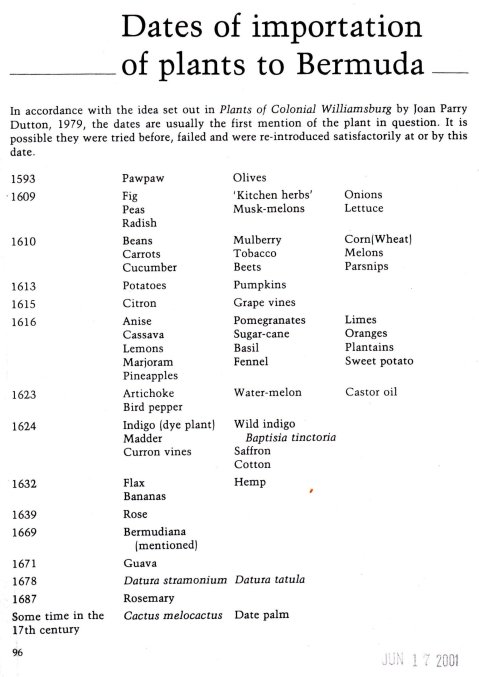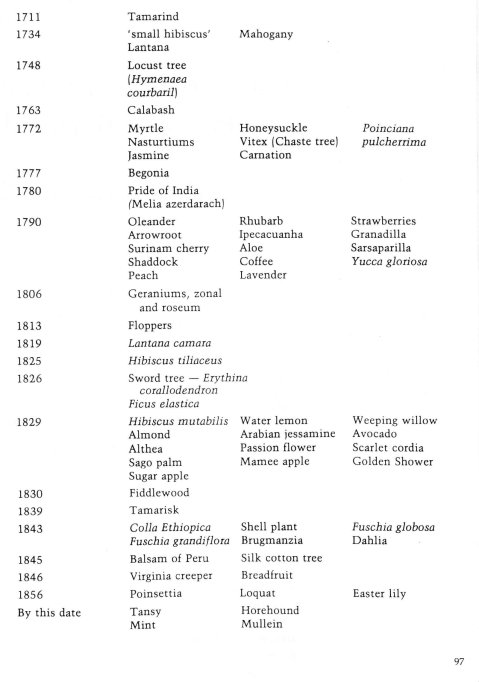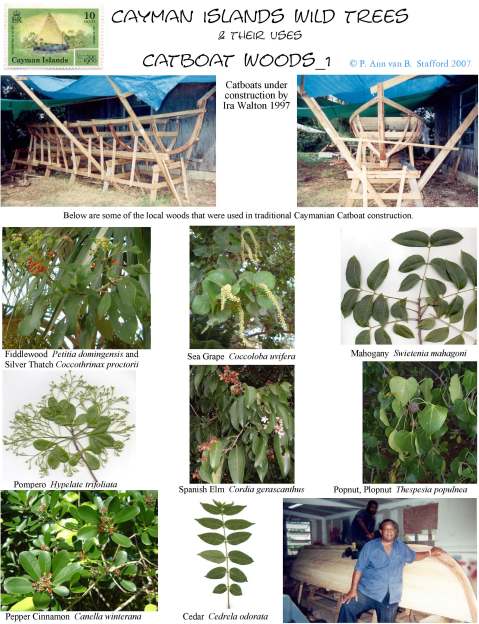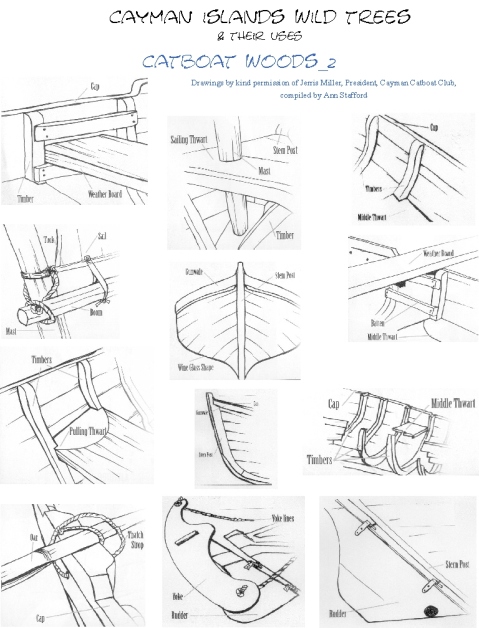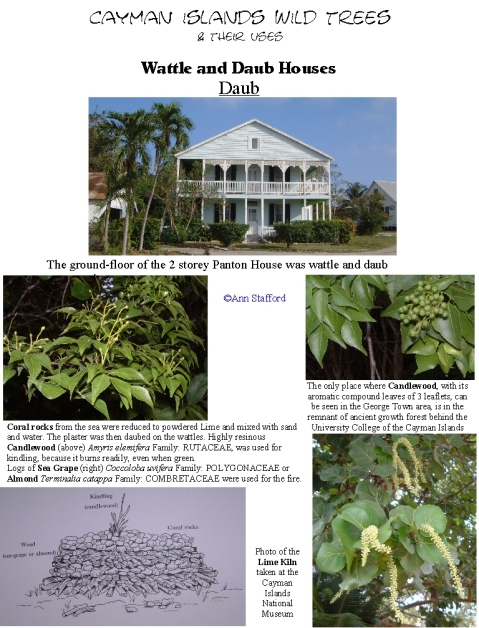Ironwood, Candlewood and Other Cayman Bush
Uses of some Plants that grow in the Cayman Islands
by P. Ann van B. Stafford, January 2018
Ethnobotany is the study of a region’s plants and their practical uses through the traditional knowledge of a local culture and people.
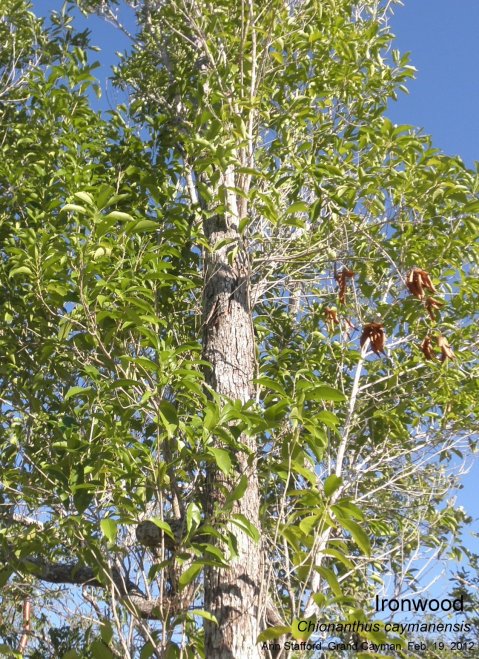
Ironwood – Chionanthus caymanensis, Endangered Cayman Islands endemic
 Ironwood flowers
Ironwood flowers
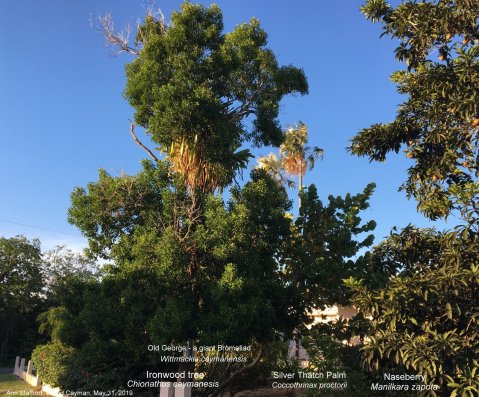 Ironwood tree with Old George (Wittmackia caymanensis = Hohenbergia caymanensis), a giant Bromeliad, in its branches, and Silver Thatch palm – three Cayman endemic plants, and Naseberry (Sapodilla) Manilkara zapota naturalized, in a George Town garden.
Ironwood tree with Old George (Wittmackia caymanensis = Hohenbergia caymanensis), a giant Bromeliad, in its branches, and Silver Thatch palm – three Cayman endemic plants, and Naseberry (Sapodilla) Manilkara zapota naturalized, in a George Town garden.
Introduction
The CAYMAN ISLANDS were discovered by Columbus over 500 years ago. Permanent settlement came later. Indigenous plants were used for shelter, food, clothing, healing, everyday utility, boatbuilding, livelihood and export. They are part of the history, culture and identity of the Cayman Islands and what makes them unique. We don’t have large wild animals, but we do have an interesting diversity of wildlife, for which plants provide food and shelter. Native plants and animals are interdependent, and are part of intricate food webs.
Definitions
Cayman Native (Indigenous) Species
A Cayman Islands native species is one that occurs naturally in the Cayman Islands without direct or indirect human actions. Some plants and animals are native to only one or two of the three Cayman Islands. 415 taxa (species and varieties) formed the original, ancient flora of Grand Cayman, Little Cayman and Cayman Brac.
Cayman Endemic Species
An Cayman Islands endemic species is one that originated or evolved in a particular place, and that situation won’t change in the future. The Cayman Islands have 28 endemic taxa (species and varieties) of plant and 5 endemic subspecies of butterfly.
Cayman Common names
Different countries have different common names, sometimes more than one for the same plant, or one name may refer to several different plants. Several trees around the world are called Ironwood, but Cayman’s culturally important Ironwood trees are only found in the Cayman Islands – Chionanthus caymanensis . Scientific names avoid confusion of which plant is being referred to. Even though there are many plants, many don’t have Cayman common names – especially if they didn’t have a use. Some common names reflect how the plants were encountered.

Cayman common name / other common name(s)
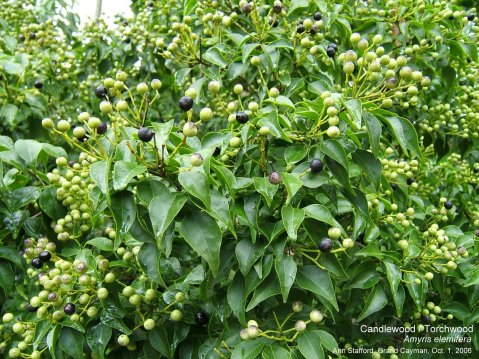
Candlewood / Torchwood – Amyris elemifera Endangered
CaymANNature Flora photo album
CaymANNature Flora_2 photoalbum
Cayman Herbarium images album
1938 Oxford University Biological Expedition to the Cayman Islands photo album
Glossary
Dioecious – plant with separate male and female flowers on different plants
Monoecious – plant with separate male and female flowers on the same plant
Polygamous – plant bearing perfect and unisexual flowers on the same plant
Kings – the island and plant collection number (GC Grand Cayman, LC Little Cayman, CB Cayman Brac) of Wilfred Kings, botanist on the 1938 Oxford University Biological Expedition to the Cayman Islands
Cultural and ecological uses
some plants may be in more than one category
- Boatbuilding
- Construction
- Export
- General Utility
- Healing
- Look, Don’t Touch
- Other Cayman Plants
Boatbuilding
Schooners
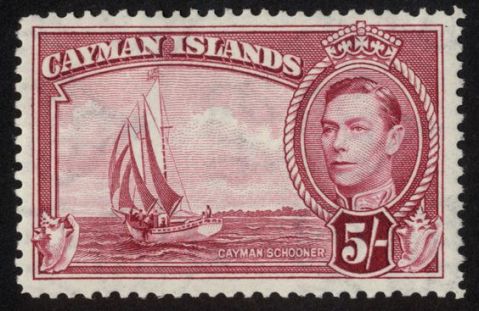
1938 King George VI 5/- (Five shilling) Cayman Schooner stamp
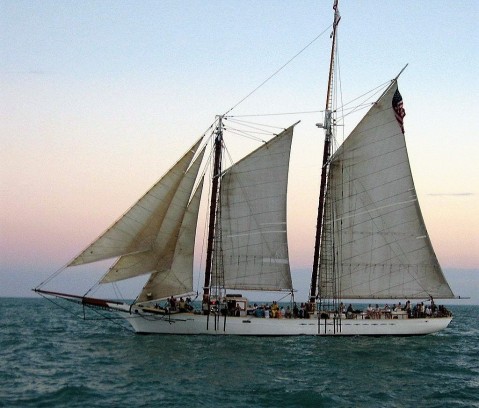
The Western Union, a schooner launched by Heber Elroy Arch in Key West in 1939, is undergoing a US$900,000 overhaul that will allow it to remain seaworthy for another decade or two. The ship, built and designed by a Caymanian, originally featured Cayman mahogany to round out its frame.
Cayman designed schooner Aug. 1, 2017

Shipbuilder Heber Arch was one of 11 children of James Arch. The family worked together in crafting boats that would traverse the Atlantic.
Catboats
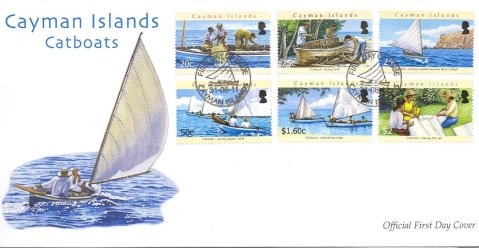 Cayman Islands Catboat stamps First Day Cover Aug. 31, 2011
Cayman Islands Catboat stamps First Day Cover Aug. 31, 2011
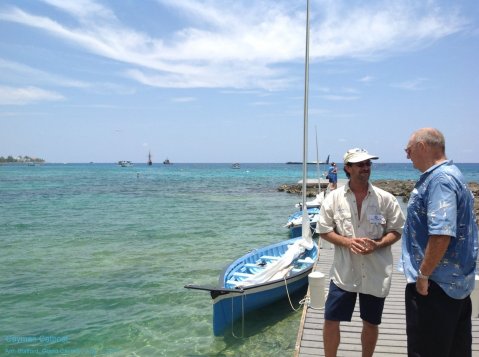
Cayman Catboats at the Cayman Catboat Club, Aug. 2, 2014

Tools used for making Catboats
Bitter Plum – Picrodendron baccatum Endangered
Flowers dioecious, without petals. The wood is very hard.
Cayman Islands, Bahamas, Cuba, Hispaniola, Jamaica and the Swan Islands.
Kings GC 131, LC 77.
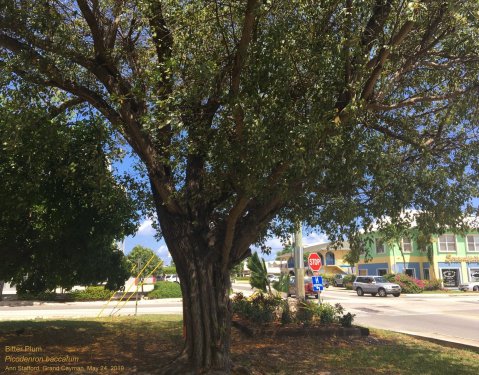 Bitter Plum tree in George Town by the Hospital crossroads
Bitter Plum tree in George Town by the Hospital crossroads


Cayman Islands, Bahamas, Cuba, Hispaniola, Jamaica and Swan Islands.
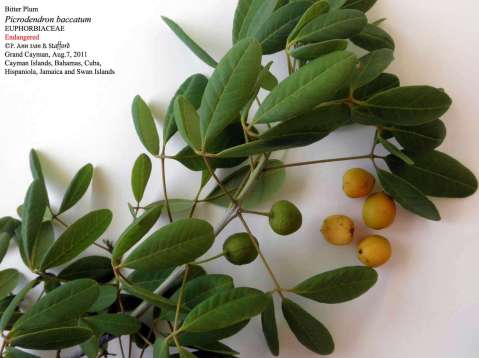 Bitter Plum has a compound leaf with 3 distinctively-shaped leaflets.
Bitter Plum has a compound leaf with 3 distinctively-shaped leaflets.
Cedar, West Indian Cedar – Cedrela odorata Critically Endangered
West Indian Cedar is related to Mahogany, and should not be confused with the evergreen conifer Cedars of the genus Cedrus, such as the magnificent spreading Cedar of Lebanon (Cedrus libani).
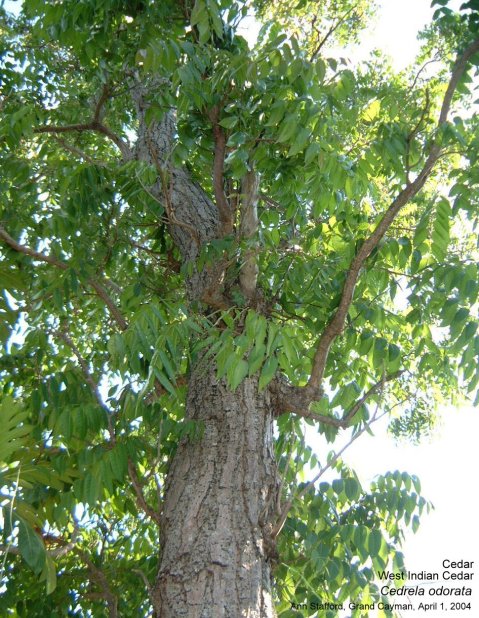 Cedar tree in George Town, April 1, 2004
Cedar tree in George Town, April 1, 2004
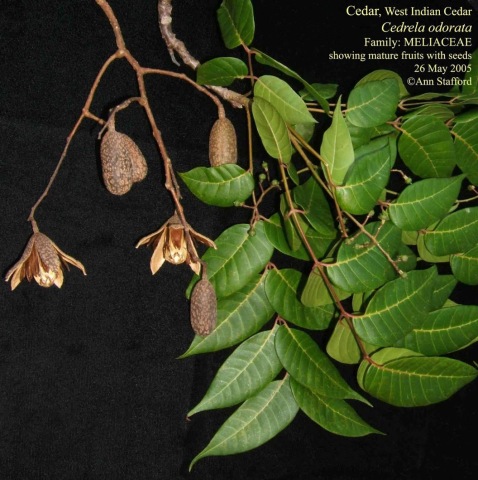 Cedar, West Indian Cedar – Cedrela odorata, mature woody capsule fruits and wind-dispersed winged seeds
Cedar, West Indian Cedar – Cedrela odorata, mature woody capsule fruits and wind-dispersed winged seeds
Fiddlewood – Petitia domingensis, Family: VERBENACEAE (LAMIACEAE), Endangered. OPPOSITE leaves. Birds love to eat the fruits, particularly Mockingbirds and White-crowned Pigeons. The wood is heavy and very hard and was used for making fence posts and in shipbuilding. Flora of the Cayman Islands, Proctor 2012 p.584, Plate 56.
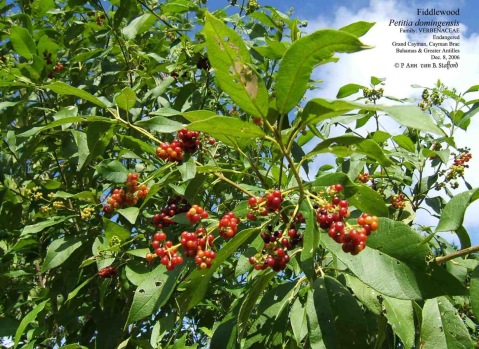
Fiddlewood – Petitia domingensis
Mahogany – Swietenia mahagoni
Mastic, Yellow Mastic – Sideroxylon foetidissimum Critically Endangered
Mastic, one of Cayman’s largest native trees, is the English common name used within its range – Central America, the West Indies (Mastic Ironwood, Mastic-bully – Bahamas) and US (southern Florida – False Mastic, Wild Mastic, Jungle Plum). It is very unusual for the Cayman common name to be the same as that in other countries, particularly the US. Mastic was used for boat-building, construction and furniture. The wood is hard, heavy, strong and durable. The heartwood is bright orange, surrounded by a yellowish band of sapwood.
 The buttressed trunk of the mighty Mastic tree, afterwhich the Mastic Trail is named
The buttressed trunk of the mighty Mastic tree, afterwhich the Mastic Trail is named
Pepper Cinnamon – Canella winterana
Pompero – Hypelate trifoliata Endangered
Pompero is an extremely slow-growing shrub or small tree and has a short, thick trunk with low, wide-spreading branches.
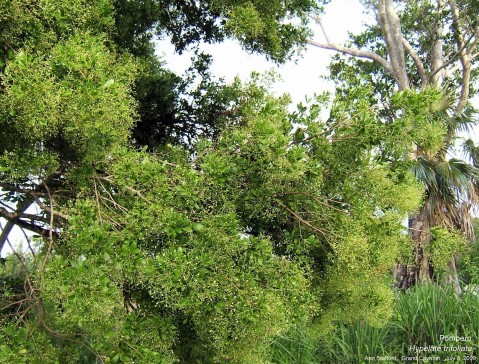 It has a compound leaf with 3 distinctive leaflets, and small white flowers.
It has a compound leaf with 3 distinctive leaflets, and small white flowers.
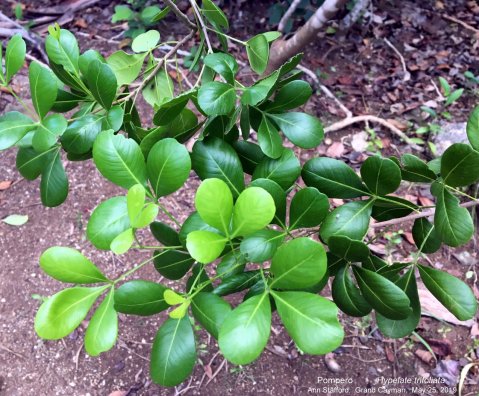
The wood very hard, heavy, close-grained, a rich dark brown and a hard timber to work. It was used for posts, shipbuilding – ribs, mostly in large vessels, and Catboat keel and keelson and tool handles.
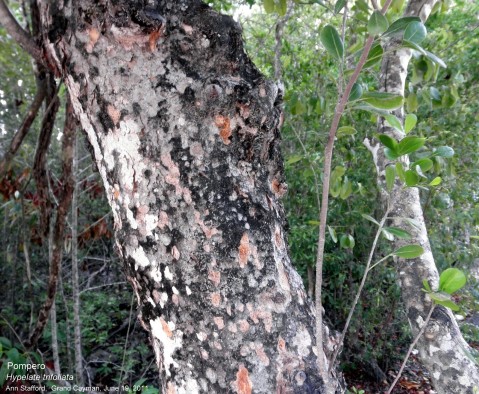
Pompero has other names: Plumperra and Wild Cherry. It is called White Ironwood in the US.
Pompero is sometimes infected with Witches’ Broom fungus in Cayman – Moniliophthora perniciosa (= Crinipellis perniciosa).
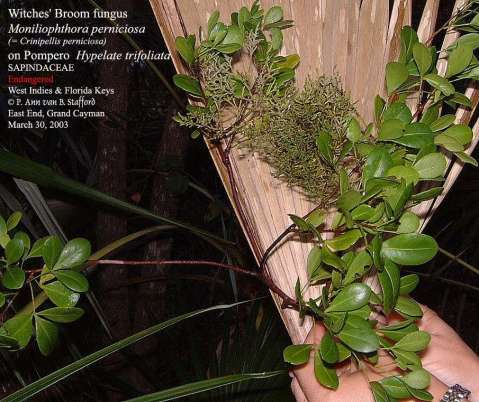
Popnut, Plopnut – Thespesia populnea
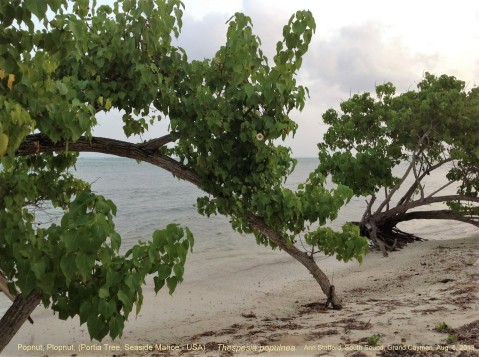
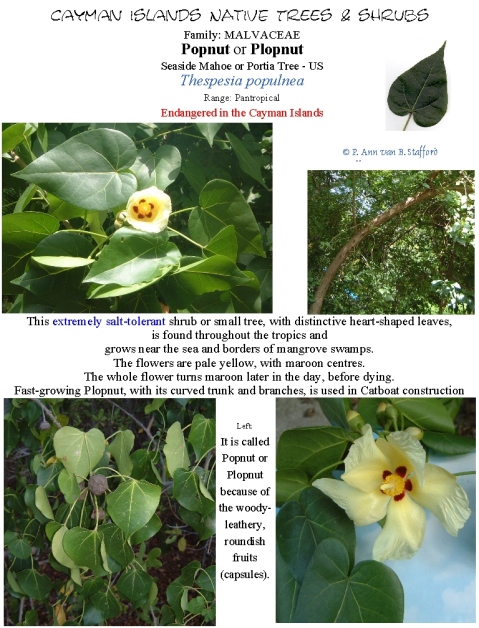
Sea Grape – Coccoloba uvifera Critically Endangered
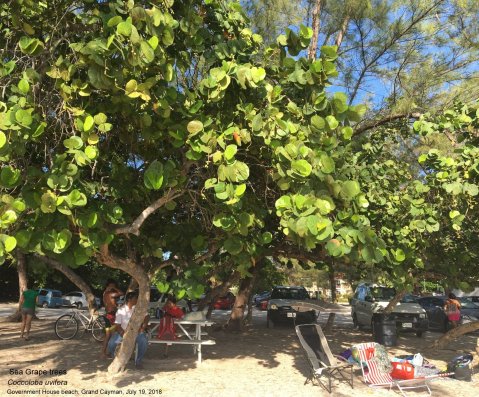
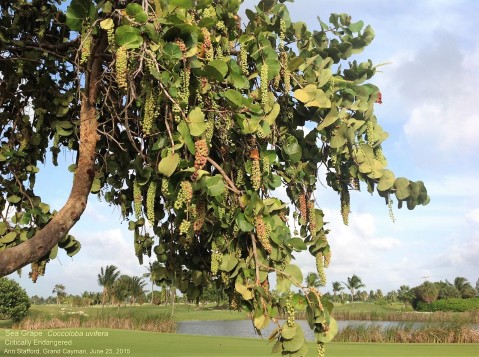
Spanish Elm – Cordia gerascanthus
Construction
Candlewood / Torchwood – Amyris elemifera Endangered
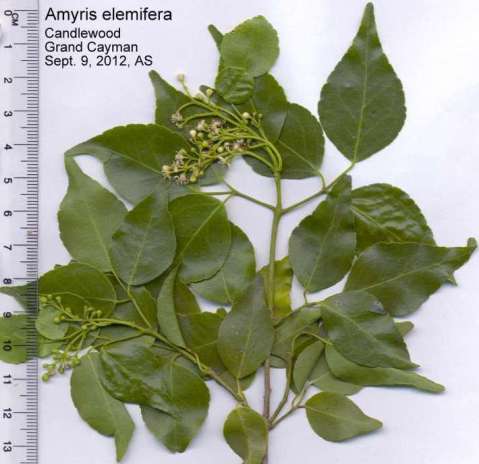
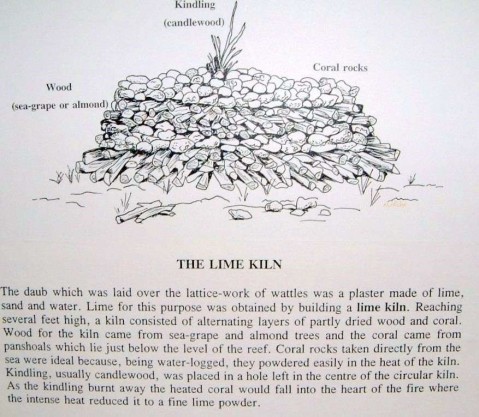
Cabbage Tree – Guapira discolor

Cabbage Tree / Blolly, Beefwood – Guapira discolor
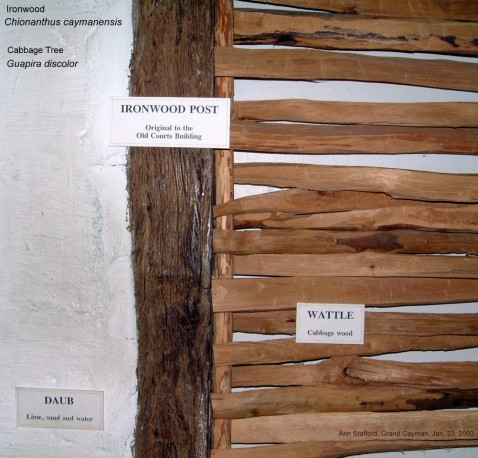
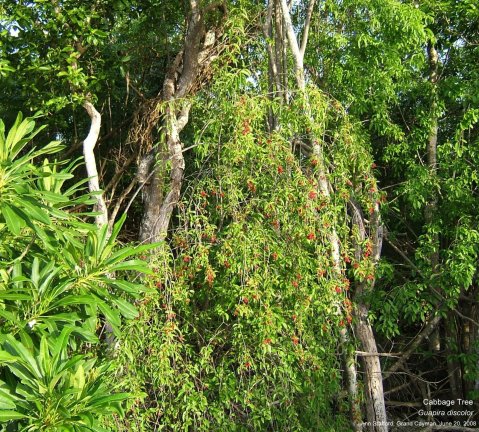
Blolly, Beeftree – Guapira discolor
Cherry – Myrcianthes fragrans, Endangered
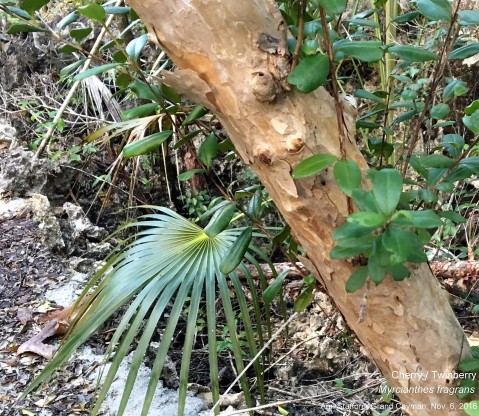
Cherry / Twinberry, Simpson’s Stopper – Myrcianthes fragrans, attractive, pinkish bark, opposite leaves, strongly aromatic when crushed. Cherry was used for wattles.

Myrcianthes fragans – Twinberry, Simpson’s Stopper
Ironwood – Chionanthus caymanensis, Endangered Cayman Islands endemic, Family: OLEACEAE, leaves arranged in exactly Opposite pairs. The heavy wood is very hard, strong, termite and water-rot resistant, not inclined to warp. It was traditionally used for the foundation posts of houses. It grows only on Grand Cayman, Little Cayman and Cayman Brac and nowhere else in the world, in rocky woodlands, close to a fresh water table.

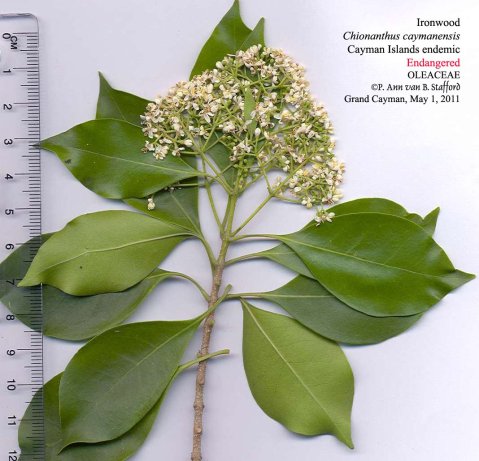 Ironwood flowers
Ironwood flowers
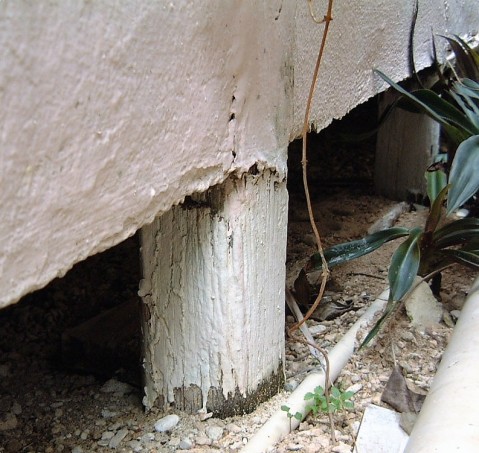 Ironwood posts, Cousin Cora’s Cottage, Boggy Sand Road, West Bay.
Ironwood posts, Cousin Cora’s Cottage, Boggy Sand Road, West Bay.
Mastic, Yellow Mastic – Sideroxylon foetidissimum Critically Endangered
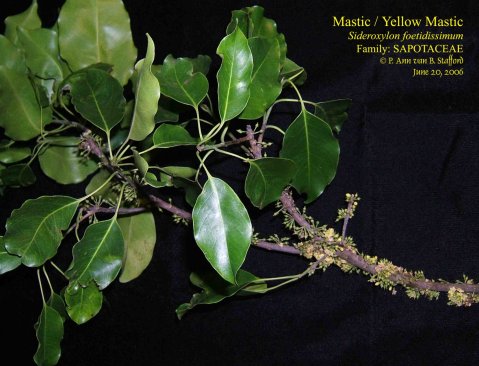 Mastic leaves have a long stalk and a minute inrolled pocket at the base of blade on upper side. The small, strongly scented flowers are yellowish.
Mastic leaves have a long stalk and a minute inrolled pocket at the base of blade on upper side. The small, strongly scented flowers are yellowish.
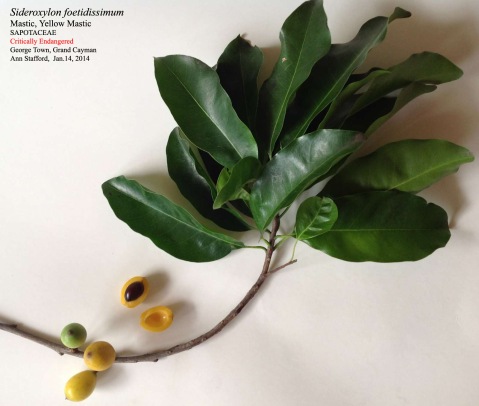 Mastic fruit, a yellow drupe, has a large single seed covered with a thin, fleshy pulp.
Mastic fruit, a yellow drupe, has a large single seed covered with a thin, fleshy pulp.
Sea Grape – Coccoloba uvifera, Critically Endangered
Silver Thatch – Coccothrinax proctorii, Endangered Cayman Islands endemic
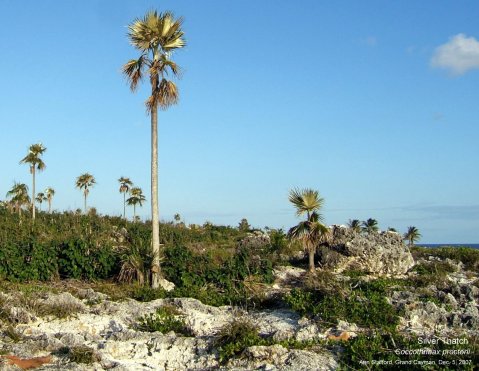 Silver Thatch trees growing on Pedro St James bluff. They grow extremely slowing, about one inch per year. The underside of the fronds are silvery.
Silver Thatch trees growing on Pedro St James bluff. They grow extremely slowing, about one inch per year. The underside of the fronds are silvery.
Spanish Elm – Cordia gerascanthus, Family: BORAGINACEAE, Endangered.
In the Cayman Islands, Spanish Elm was used in general construction and for making oars.
Greater Antilles, Mexico, Central America and Columbia.

Strawberry, (White Stopper – US) – Eugenia axillaris
Shrub or small tree with aromatic leaves, difficult to distinguish from Bastard Strawberry, (Pale Lidflower – US) – Calyptranthes pallens Endangered, except when flowering or fruiting. Strawberry wood was used to make wattles for traditional Cayman Wattle and Daub houses, and for fish pots. It also makes a good walking stick.
Florida, West Indies, Mexico and northern Central America in sandy or rocky thickets and woodlands.
Kings GC 285
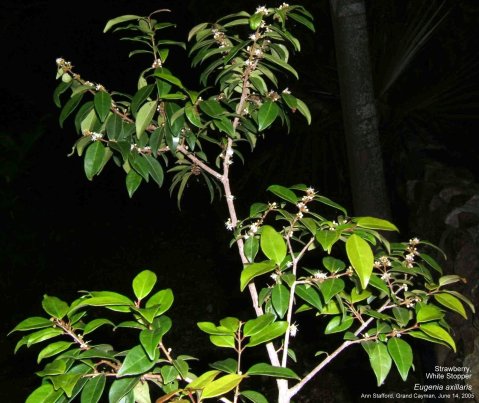
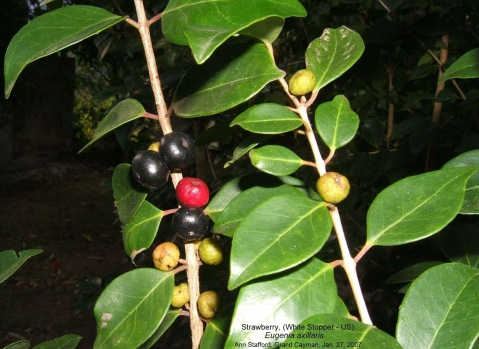 Strawberry fruits, black when ripe, are edible, but not particularly paletable.
Strawberry fruits, black when ripe, are edible, but not particularly paletable.

Wattle and Daub construction, Cayman Catboat Club
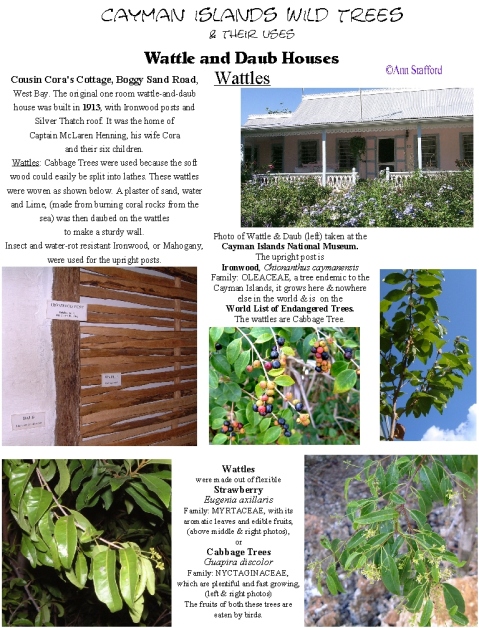
Export
Coconut Palm – Cocos nucifera.
There was a thriving Coconut industry on the Sister Islands – Cayman Brac and Little Cayman, in the late 1800s and early 1900s. The coconuts were husked before being exported. The trees succumbed to a disease – lethal yellowing.

Cotton, Wild Cotton, Short-staple Cotton – Gossypium hirsutum var. punctatum
Cotton was exported from 1780s. It was the most valuable cargo between 1802 and 1804. All of the cotton plantations were in south central Grand Cayman, averaging about 100 acres.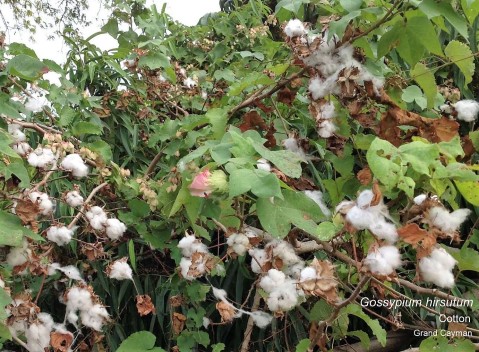
Cayman’s cotton industry declined after 1810.
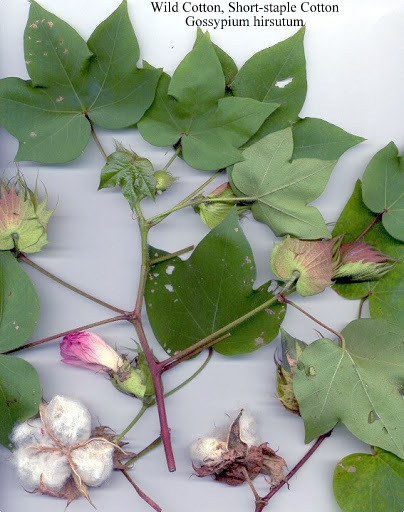
Wild Cotton, Short-staple Cotton – Gossypium hirsutum
Fustic – Maclura tinctoria (dye wood), Critically Endangered, Family: MORACEAE
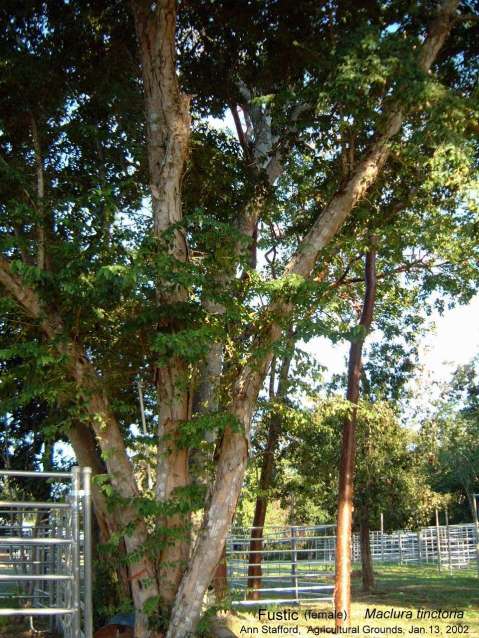
Fustic wood is tough and close-grained. It was exported from mid-1700’s to early 1800’s for khaki or fustic, a yellowish dye extracted from the wood, which was used for dyeing cloth for military uniforms and schoolboys clothing. It grows in Grand Cayman, Cayman Brac, the West Indies and continental tropical America.
Flora of the Cayman Islands, Proctor 2012 p.241, Fig.84.
Kings GC 408
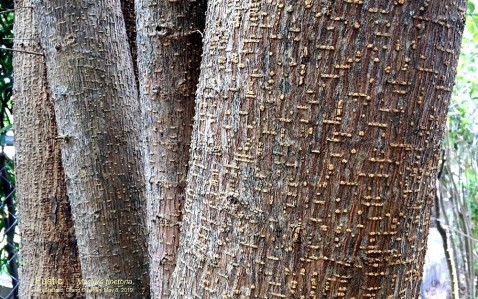
Fustic is DIOECIOUS – male and female flowers grow on separate trees, fruits form from female (pistillate) flowers only.
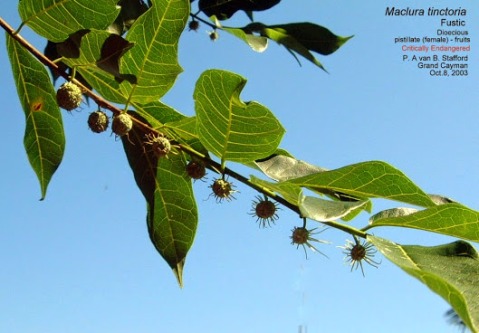

Logwood – Haematoxylum campechianum (dye wood), introduced from Central America. Logwood is a small, thorny tree with a deeply fluted trunk and wide spreading branches. It grows fast and aggressively colonizes in low-lying damp ground, that is not too salty. The wood is hard, heavy and slow to rot and is still used for fence posts.
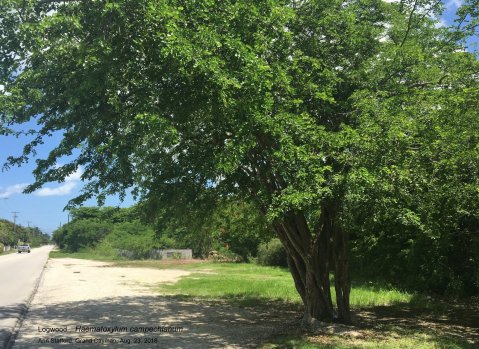
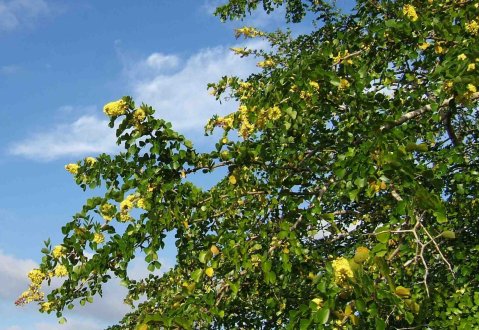
Bees make honey from Logwood flowers. Logwood, native to Central America, is naturalized in the West Indies, where it was introduced early in the 18th. century as an export for its bluish-black dye from the red heartwood. It was a source of dye formerly used for textiles and which is still highly valued as a bacteriological and cytological stain.
Logwood is invasive in Cayman
Mahogany – Swietenia mahagoni, Endangered. 1730s – 1740s The first formal land grants were made in Cayman, mainly to cut Mahogany. Mahogany furniture had become popular in Britain and Europe and Mahogany surpassed turtle as Cayman’s most valuable product.

The same huge Mahogany tree in East End, before and after Hurricane Ivan (Sept. 2004)

Red Mangrove – Rhizoraphora mangle Near Threatened
Red Mangrove trees contains tannins and were barked from the early 1900s to 1930s in Cayman. This was shipped to Jamaica and thence to Europe for tanning leather. The barked trees died afterwards.
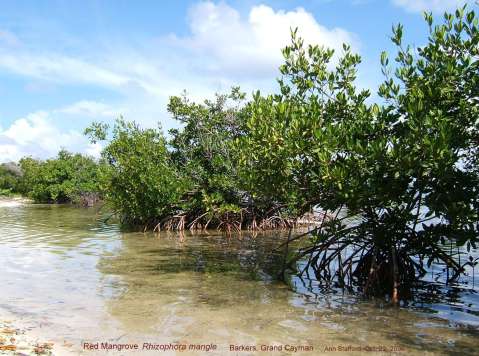
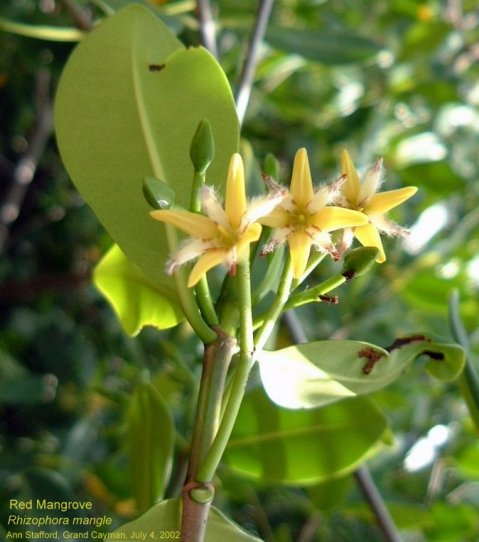 Red Mangrove flowers – 4 white petals, 4 yellow sepals
Red Mangrove flowers – 4 white petals, 4 yellow sepals
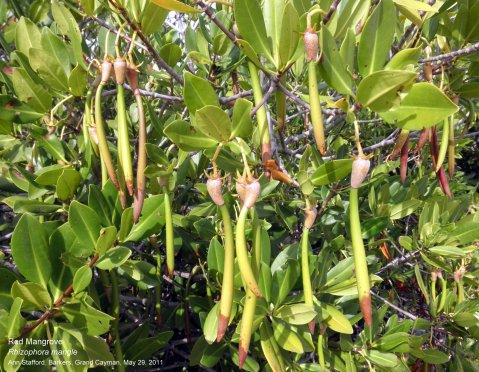 Red Mangrove propagules – elongated torpedo-like seedlings that develop from brown, oval fruits while they are still attached to the tree.
Red Mangrove propagules – elongated torpedo-like seedlings that develop from brown, oval fruits while they are still attached to the tree.
Satinwood, Yellow Sanders – Zanthoxylum flavum Critically Endangered
Dioecious or polygamous (bearing perfect or inisexual flowers on the same plant) tree, Florida, Bermuda, West Indies, extremely rare on all three Cayman Islands. Satinwood was highly prized for its yellow, satiny lustre that took a high polish and was used in cabinetry and furniture.

The compound leaves have pellucid dots with oil glands.
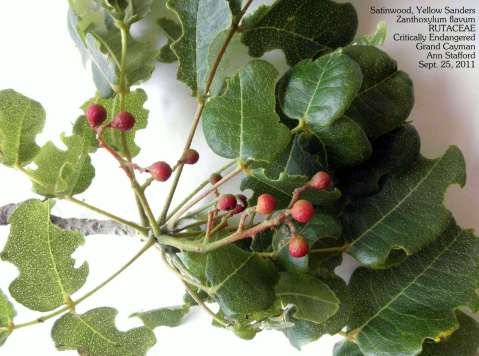
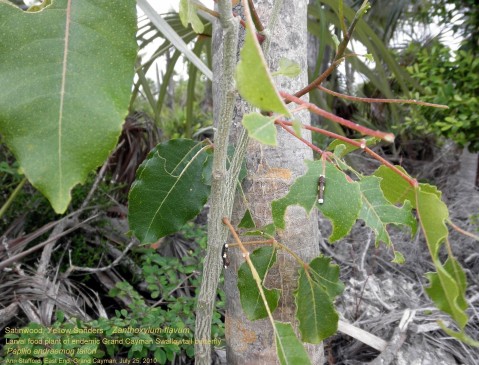
Satinwood is a larval food plant of the endemic Grand Cayman Swallowtail butterfly – Papilio andraemon tailori (two caterpillars in the photo).
Satinwood – Zanthoxylum flavum
‘The tree has an excellent, ornamental timber that was highly desired for inlay, fine furniture etc. It was so heavily exploited that large trees are now almost unheard of.’
Silver Thatch – Coccothrinax proctorii (rope), Endangered Cayman Islands endemic
Cayman Islands National Tree

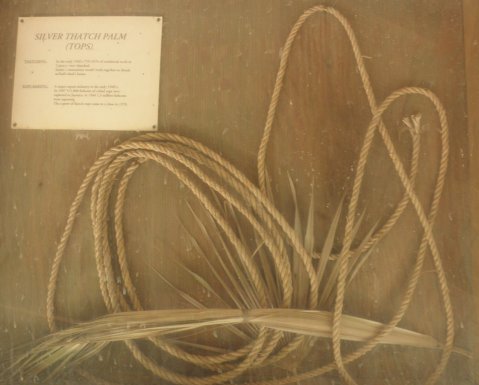
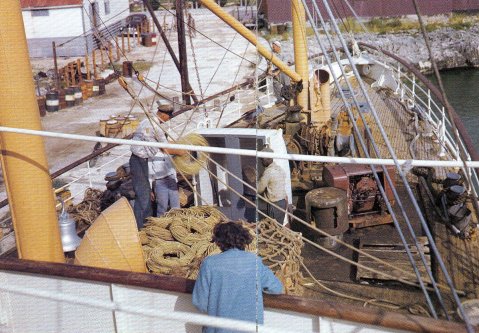 Rope made from the ‘tops’ Silver Thatch palm was exported to Jamaica.
Rope made from the ‘tops’ Silver Thatch palm was exported to Jamaica.
General Utility
Banana Orchid – Mymecophila thomsoniana
Cayman Islands National Flower
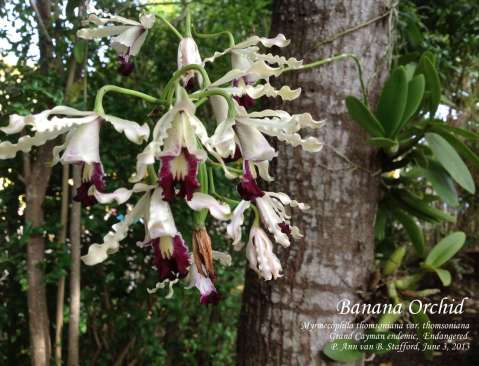
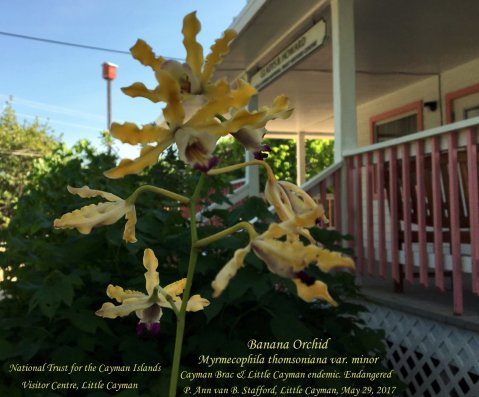
Calabash (or Gourd) tree – Crescentia cujete, Family: BIGNONIACEAE. The sprawling tree bears large green fruits, gourds (up to 25 cm in diameter) – the woody outer shells were traditionally used to make water containers, soup bowls, plates and for bailing boats. Florida, West Indies and continental tropical America.

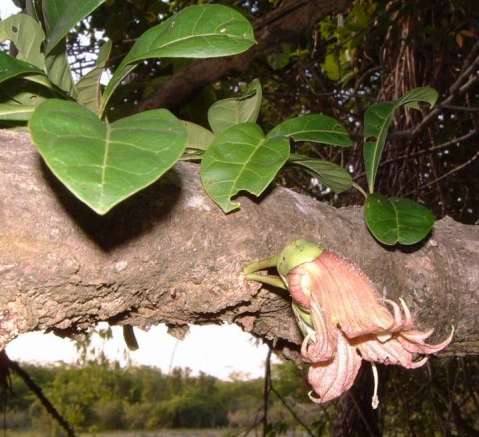 Calabash, Gourd tree, has trumpet-shaped flowers that sprout directly from the branches and trunk and are pollinated by Buffy Flower bats.
Calabash, Gourd tree, has trumpet-shaped flowers that sprout directly from the branches and trunk and are pollinated by Buffy Flower bats.
Cedar, West Indian Cedar – Cedrela odorata Critically Endangered
Cedar has large, compound leaves (similar to Maiden Plum) and aromatic, reddish wood, soft but durable, resistant to attack by insects. In addition to boat-building, Cedar was used for cigar boxes, musical instruments, light construction, veneer and plywood.
Grand Cayman, Cayman Brac, West Indies and continental tropical America.
Kings GC 337
 Cedar tree growing through a fence in George Town.
Cedar tree growing through a fence in George Town.
Cedrela odorata: Useful Tropical Plants
Coconut Palm – Cocos nucifera
 Coconut Palm trees by the Lake at the Queen Elizabeth II Botanic Park
Coconut Palm trees by the Lake at the Queen Elizabeth II Botanic Park
Corato, Cordo, Corto – Agave caymanensis* Vulnerable Cayman Islands endemic to the three Cayman Islands
Corato grows in dry shrubland, especially at the drier eastern ends of each island. Corato is a large, fleshy, rosette plant with massive, succulent, spine-tipped leaves. It develops a woody trunk at maturity. The flowers are yellow, and small vegetative bulbils, miniature plants, are produced on the inflorescence after flowering.
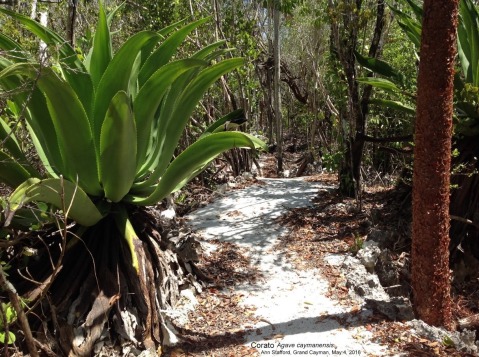
Like all Agaves, it is monocarpic, flowers only once in its lifetime and dies afterwards.
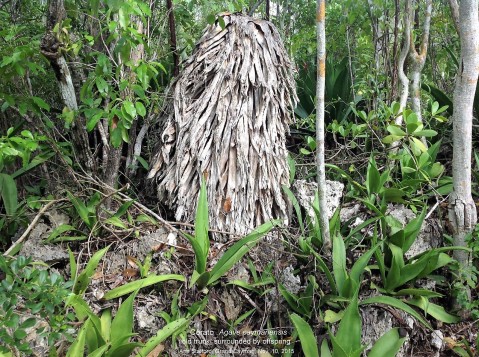
Corato leaves were dried and used for scrubbing floors. People didn’t have soap powder. The leaves were cut and pounded, to make them soft. Ashes and water were poured on them to make LYE water for doing laundry.
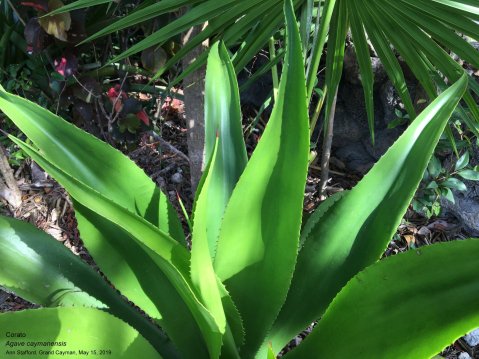
Guava – Psidium guajava
Shrub or small tree, naturalized in Cayman, has 4-angled branchlets and leaves with numerous pellucid dots. The fruit is a pinkish or yellowish edible berry with numerous small seeds. Gigs (spinning tops) were made from Guava wood.
Guava grows in the American tropics; it is grown for its edible fruits and becomes naturalized.
Kings 385
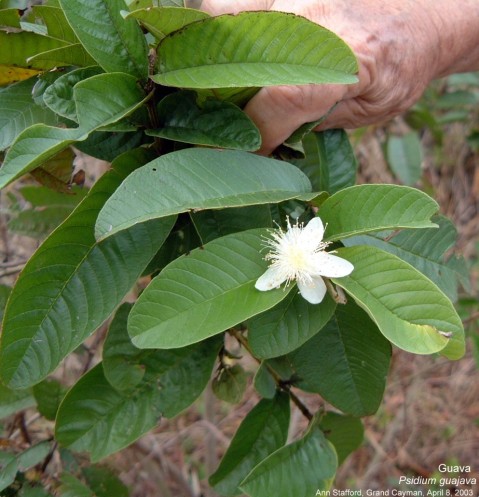
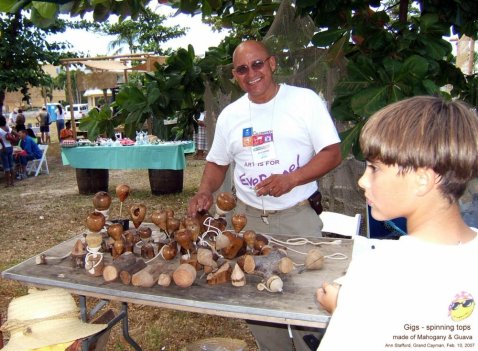 Gigs (spinning tops) made from Mahogany and Guava wood
Gigs (spinning tops) made from Mahogany and Guava wood
Mastic, Yellow Mastic – Sideroxylon foetidissimum Critically Endangered
Mastic was used for boat-building, construction and furniture
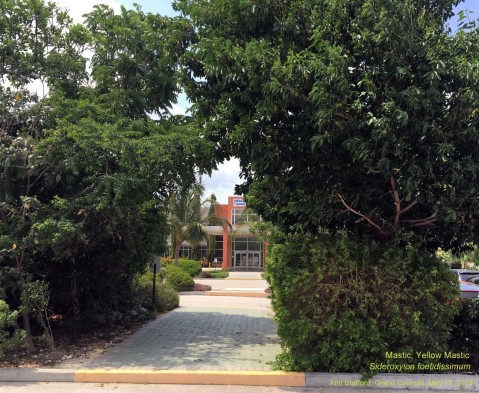 Mastic tree, flowering, at Health City, Grand Cayman, May 17, 2019
Mastic tree, flowering, at Health City, Grand Cayman, May 17, 2019
Naseberry, Sapodilla – Manilkara zapota
Kings GC 347
Sapodilla, Naseberry – Manilkara zapota – Useful Tropical Plants
Silver Thatch – Coccothrinax proctorii (rope), Endangered Cayman Islands endemic
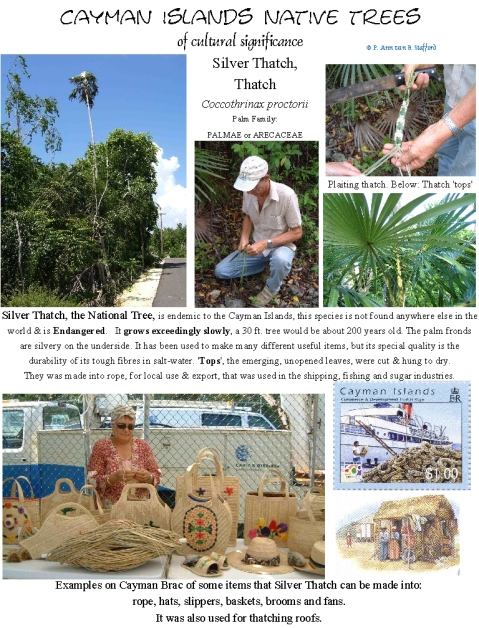
Sisal, Sisal Hemp – Agave sisalana – introduced, naturalized, invasive
Dark brown, very sharp pointed spine at the tips of the leaves. Edgar Samuel McCoy (born in 1851) was a pioneer of the Sisal industry in Grand Cayman.
1910 Hirst’s Notes on the History of the Cayman Islands: Many acres have been laid out in Agave sisalana and many more will be laid out shortly …… Sisal bears after 3 years, whereas coconut bears after at least 6 years. The Sisal plant is unaffected by drought or hurricanes, while the coconut is seriously affected by both.
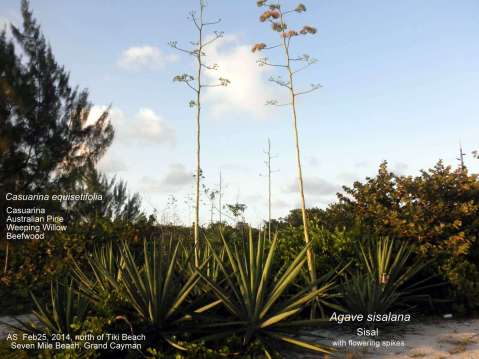 Sisal tends to persist after cultivation.
Sisal tends to persist after cultivation.
Slingshot, Wild Jasmine – Tabernaemontana laurifolia Endangered
White latex
Dry rocky thickets and woodlands
Grand Cayman and Jamaica only
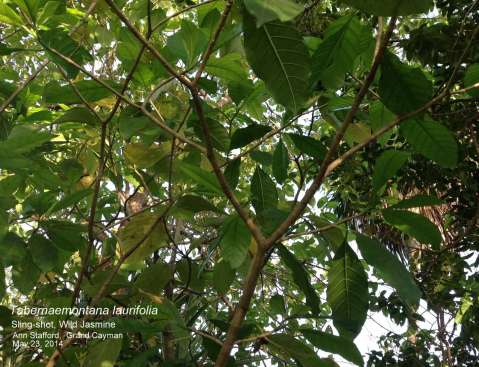
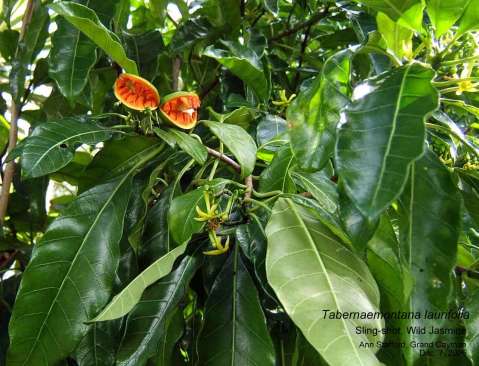
Smoke Wood – two species grow in Cayman, one is common, the other is rarer. They have similar leaves, white flowers and red fruits (a drupe). Smoke Wood was one of the woods burnt in smoke pots, cans filled with smouldering wood to ward off mosquitoes, an introduced menace. There was no mention of mosquitoes in early records. None of the three species of Erythroxylum in Cayman contains cocaine, which is obtained from the leaves of Erythroxylum coca that grows in the Andean region of South America.
Smoke Wood – Erythroxylum areolatum
Cayman Islands, Bahamas, Greater Antilles, Mexico, and northern Central America, in rocky woodlands.
Kings GC 204a, GC 333
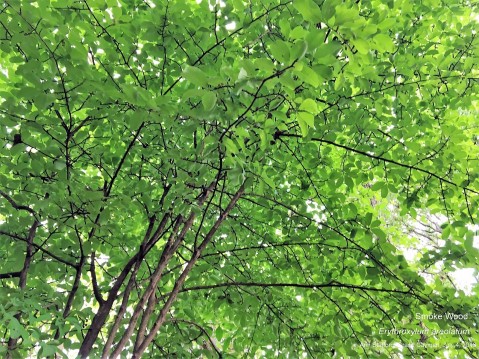 The wood is hard, heavy, fine-textured and very durable. It was used for fence posts.
The wood is hard, heavy, fine-textured and very durable. It was used for fence posts.
 Two faint parallel lines can be seen on either side of the main vein on the underside of the leaf. A beetle pollinates the white flowers.
Two faint parallel lines can be seen on either side of the main vein on the underside of the leaf. A beetle pollinates the white flowers.
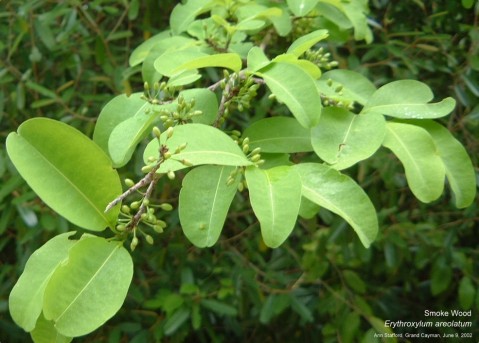
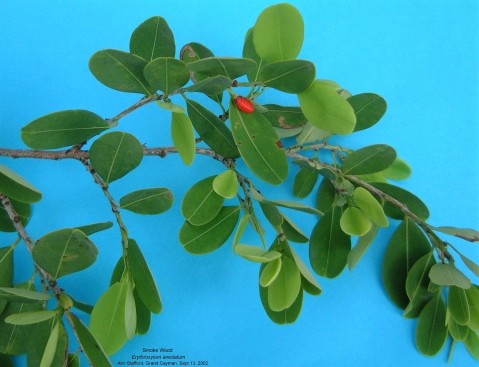 Smoke Wood fruits of both species are bright red when ripe.
Smoke Wood fruits of both species are bright red when ripe.
Smoke Wood – Erythroxylum confusum Critically Endangered
grows in seasonally flooded sinkholes.
Grand Cayman, Bahamas, Cuba and Jamaica.
 Smoke Wood (Erythroxylum confusum) with Resurrection Fern (Polypodium polypodioides) growing on the corky-looking bark of its trunk at the Queen Elizabeth II Botanic Park on the Woodland Trail.
Smoke Wood (Erythroxylum confusum) with Resurrection Fern (Polypodium polypodioides) growing on the corky-looking bark of its trunk at the Queen Elizabeth II Botanic Park on the Woodland Trail.
Resurrection Fern fronds curl up in dry weather and look dead, but open up and become green after rain.
Kings F 32, F 32-a, F 36, F 45

Strawberry (White Stopper – US) – Eugenia axillaris
 Calavans (traps) were made from trees with straight, durable limbs such as Strawberry, Cabbage or Shamrock. The new, young leaves of Strawberry are pinkish-red.
Calavans (traps) were made from trees with straight, durable limbs such as Strawberry, Cabbage or Shamrock. The new, young leaves of Strawberry are pinkish-red.
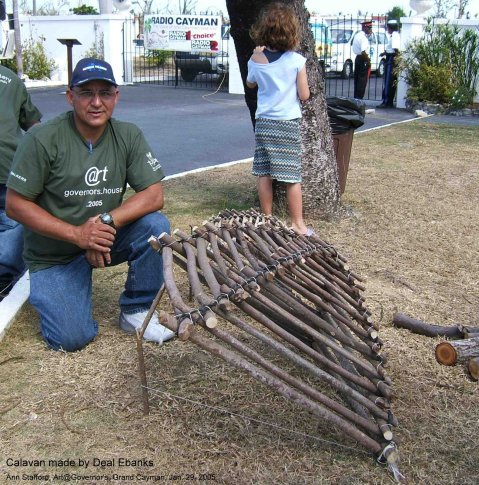 Calavan (trap) made by Deal Ebanks
Calavan (trap) made by Deal Ebanks
Wash Wood – Jacquinia keyensis Endangered
Wash Wood (called Joewood in the US), extremely slow-growing and salt-tolerant, was used to wash clothes. The bark was scraped off, the trunk chopped – tapped, and a container used to collect the beige sap. The sap was mixed with lye water – well-water which had been mixed with ashes, allowed to stand & strained off.
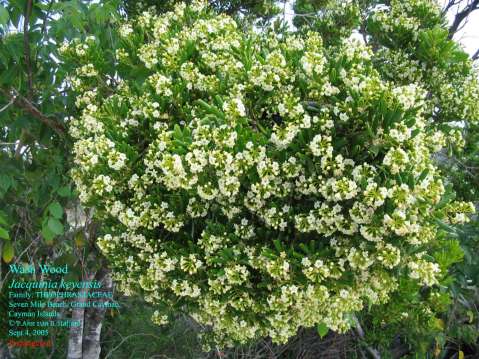
Grand Cayman, Cayman Brac, Florida, the Bahamas, Cuba, and Jamaica, in coastal scrub-lands and thickets.
Kings GC 172
 Wash Wood habitat, North Sound, West Bay
Wash Wood habitat, North Sound, West Bay
Cayman Cultural Trees – Stamps
 Wash Wood – Jacquinia keyensis 15 cent stamp, release date Feb. 23, 2006
Wash Wood – Jacquinia keyensis 15 cent stamp, release date Feb. 23, 2006

Wash Wood, Proctor’s Jacquinia – Jacquinia proctorii Critically Endangered
Cayman Islands and Jamaica
Kings GC 334

Wild Cinnamon – Croton nitens Endangered
Aromatic leaves, minutely pellucid dotted, (not to be confused with Pepper Cinnamon – Canella winterana, which also has aromatic leaves).
Dry rocky woodlands
Jamaica, Swan Islands, Mexico and Central America
 Flowers, fruits and bright orange dying leaf
Flowers, fruits and bright orange dying leaf
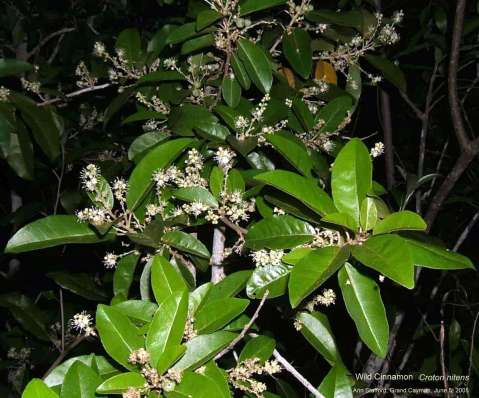
Wild Cinnamon wood used for making fish-pot frames, the wood sinks and is durable in salt water.
Healing
The information is for educational purposes only and is not intended to be an endorsement of any of the old-time remedies. Some parts of a plant, ripe or unripe, may heal, while other parts of the same plant may be poisonous. There may be a fine line between kill and cure.
decoction – boiled; the liquor resulting from concentrating the essence of a substance by heating or boiling, especially a medicinal preparation made from a plant.
infusion – steeped; a drink, remedy, or extract prepared by soaking the leaves of a plant or herb in liquid.
Medicinal Plants and Cultural Uses photo album
Aunt Eliza Bush, (Twining Soldierbush) – Myriopus volubilis = Tournefortia volubilis
Kings GC140, LC 12
Aloe Vera “Sempervivie”, ‘Alloways” – Aloe vera
Basil “Tea Basil” , Pimento Basil, (Least Basil) – Ocimum campechianum = O. micranthum
Kings GC 213; LC 6.
Basil “Sweet” – Ocimim basilicum
Birch – Bursera simaruba
Broadleaf – Cordia sebestena var. caymanensis
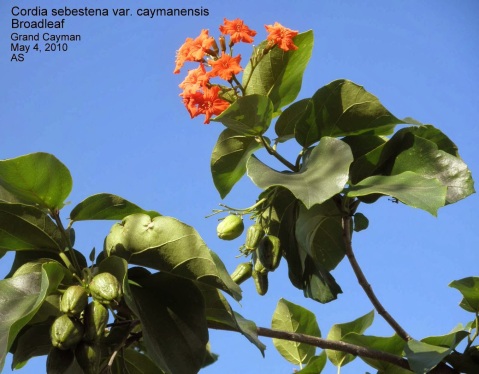
Castor Oil Plant, Castor Bean – Ricinus communis. Family: EUPHORBIACEAE.
A wide-branching shrub 2-5 m tall, with watery sap and ALTERNATE leaves, native to Africa. It is monoecious: separate female (upper) and male (lower) flowers are borne on the same plant. The fruit, a capsule, is usually spiny and the seeds mottled. The seeds and leaves have been used since ancient times as a purgative and emollient. It was one of the most popular and revered plants in Cayman. Habitat: old fields, roadsides, open waste ground, gardens.
Warning: the seeds contain the highly POISONOUS phytotoxin RICIN and can be fatal if swallowed. Heat inactivates ricin (a protein).
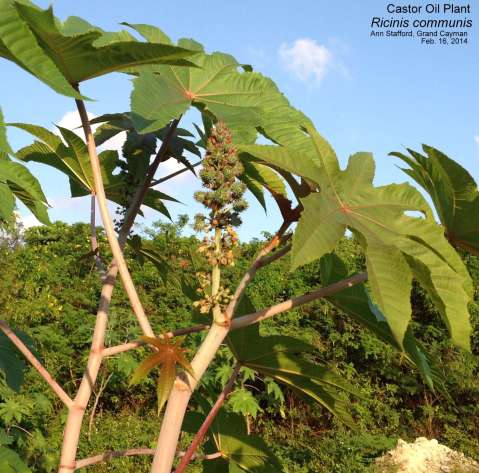
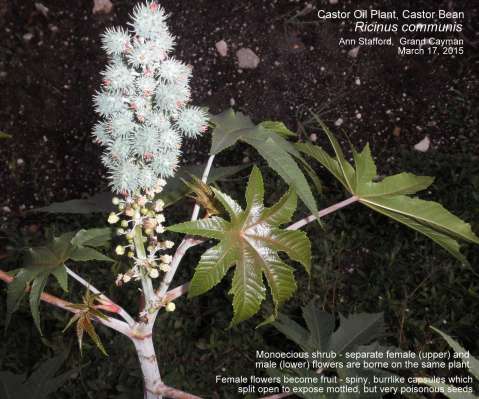
Castor Oil Plant, Castor Bean – Ricinus communis
Castor Oil Plant – Ricinus communis
Cochineal, “Scotchineal” – Nopalea cochenillifera (syn. Opuntia cochenillifera)
A cactus naturalized in Cayman, edible fruits.
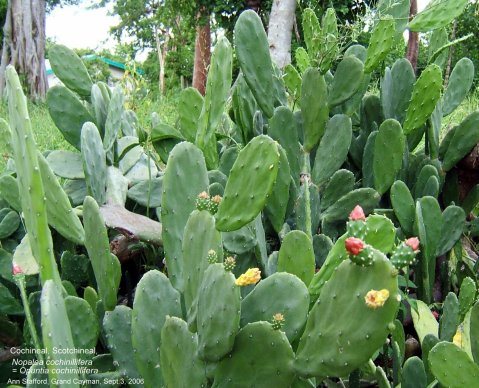
Kings GC 340; CB 33.
Coconut – Cocos nucifera
Kings CB 52, CB 53
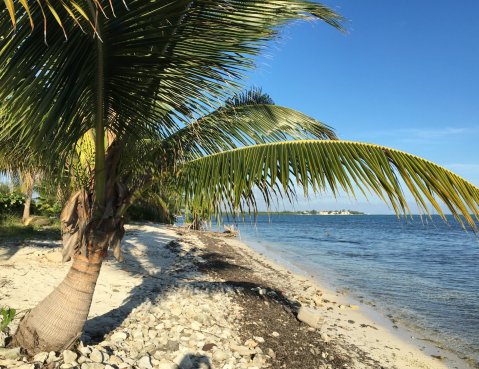 Coconut Palm on South Sound beach, looking across to Prospet Point, an area of early settlement.
Coconut Palm on South Sound beach, looking across to Prospet Point, an area of early settlement.
Cowitch – Mucuna pruriens
A herbaceous vine that grows over other vegetation.
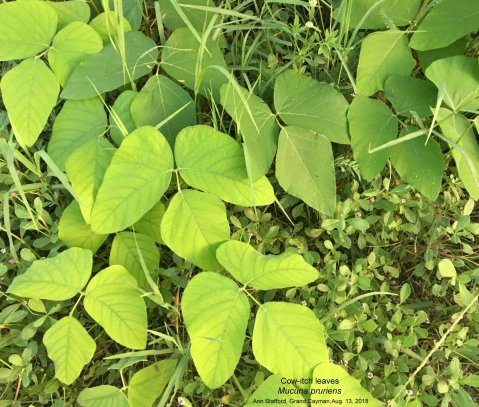 The distinctive compound leaf has 3 leaflets, the mid-veins of the 2 side leaflets are off-center.
The distinctive compound leaf has 3 leaflets, the mid-veins of the 2 side leaflets are off-center.
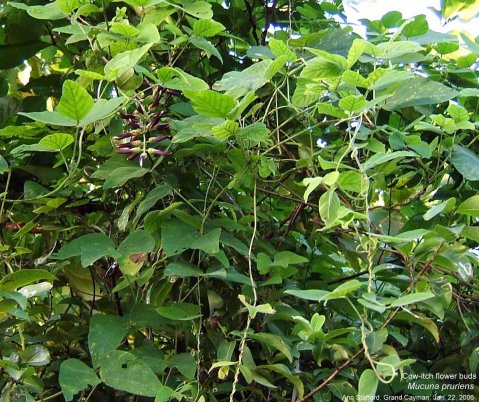 Flowers are a dull dark purple. The velvety-brown seed pods are covered with stinging hairs which cause intense itching. They cannot be washed off. Naturalized in Cayman, pantropical
Flowers are a dull dark purple. The velvety-brown seed pods are covered with stinging hairs which cause intense itching. They cannot be washed off. Naturalized in Cayman, pantropical
Applying flour to the affected area relieves the itching.
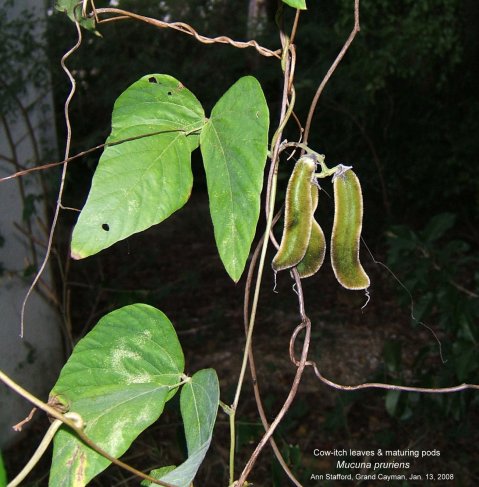
Cow-itch – Bush Medicine – Cayman Islands National Museum
The hairs of the pods were used to get rid of intestinal worms. This remedy was dreaded by Cayman children. “We were dosed with this thing made by scraping the pods on the cow-itch plants. That was mixed with green banana which had been boiled in milk with some sugar in it. We would have to eat the wretched thing.”
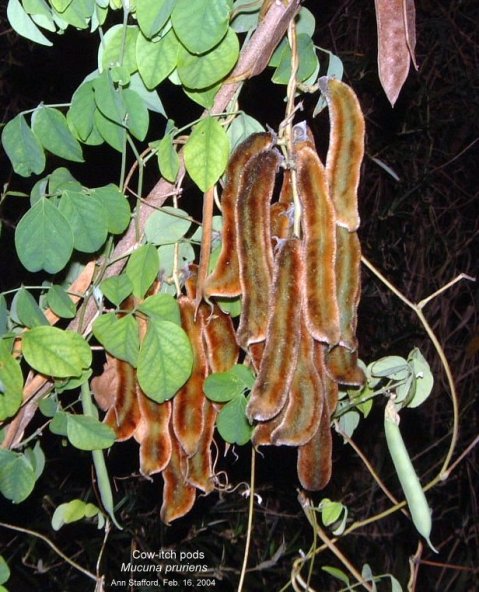
Kings GC 228
Dandelion – Senna occidentalis
Dandelion, Coffee Senna, Stinking Bush, Septic Weed – Senna occidentalis (syn. Cassia occidentalis), Family: FABACEAE (LEGUMINOSAE, subfamily: CAESALPINIOIDAE).
An erect shrubby annual herb, to about 1 m tall, often subwoody near the base.
Compound leaves that have an unpleasant odour when crushed, flowers yellow, pods oblong-linear, slightly curved. The dried root was used for loss of apetite. The roasted and pulverized brown seeds were used as a substitute for coffee. It is the larval food plant of the Cloudless Sulphur butterfly – Phoebis sennae.
Kings GC 220
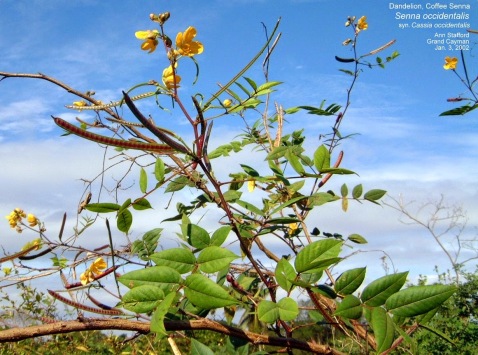
Dandelion – Senna occidentalis
Dashalong – Turnera ulmifolia, Family: TURNERACEAE.
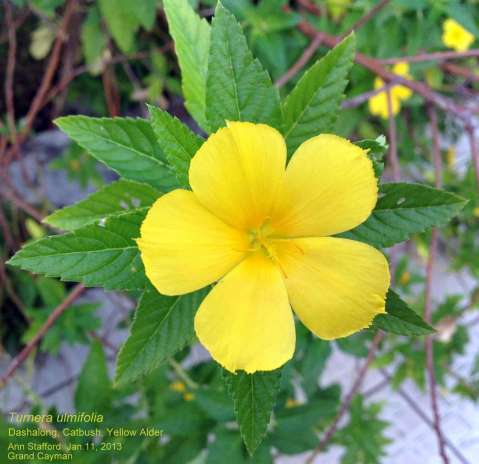 Dashalong leaves were boiled to make a tonic tea, for liver and kidney trouble and for coughs and colds. It is the larval food plant of the Mexican Fritillary butterfly (Euptoieta hegesia).
Dashalong leaves were boiled to make a tonic tea, for liver and kidney trouble and for coughs and colds. It is the larval food plant of the Mexican Fritillary butterfly (Euptoieta hegesia).
Dogwood, Jamaica Dogwood, Fishfuddle Tree, Fish Poison Tree – Piscidia piscipula, Family: FABACEAE, Endangered. Leaves Alternate, compound, odd-pinnate. Pink flowers in panicles, pod greenish-yellow, straw-coloured at maturity, with papery wings.

The bark, especially of the roots, is well-known for its narcotic and poisonous properties. It has been used to relieve toothache and for curing mange in DOGS. If the bark and leaves are crushed and thrown into water, most nearby fish will become stupified and will float on the surface. The fruit has been used in South America for arrow poison.
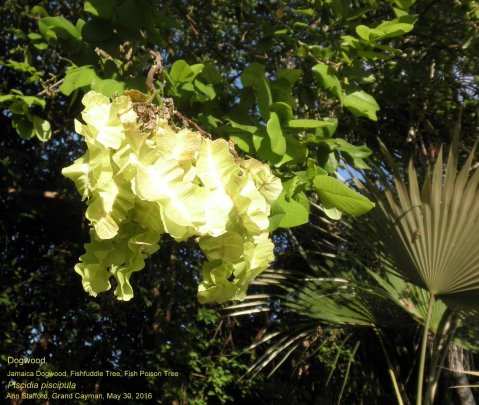 Dogwood – Piscidia piscipula Note: Care must be taken with the use of this plant. Cayman Islands National Archive Oral History: A tea made from bark and leaves was ‘just nice”. Sap will draw a prickle from a finger.
Dogwood – Piscidia piscipula Note: Care must be taken with the use of this plant. Cayman Islands National Archive Oral History: A tea made from bark and leaves was ‘just nice”. Sap will draw a prickle from a finger.
Jamaica Dogwood, Florida Fishpoison tree – Piscidia piscipula
Eucalyptus – Eucalyptus globulus, Family: MYRTACEAE. used as a balsamic, a hypoglycaemic and an antiseptic. The terpenoid volatile oil, cineol, is an expectorant and has a stimulating effect. Used as an inhalant.
Leaves of Eucalyptus “were made into a tea and the leaves were steeped in the bath and that was used to bathe you and steam you, for bad cold or pneumonia”. Eucalyptus oil is one of the active ingredients of Vicks VapoRub.
The bark was burned to ward off mosquitotes.
Eucalyptus, Blue Gum – Eucalyptus globulus, KEW
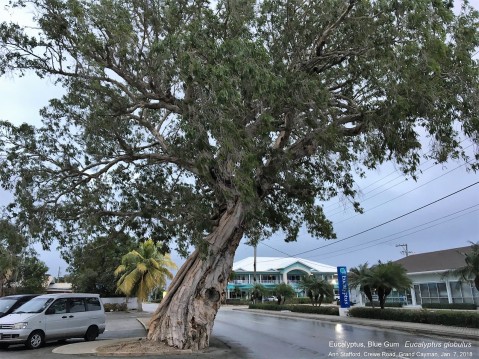 Eucalyptus – Eucalyptus globulus, Shedden Road, opposite the Eucalyptus Building. The tree pictured above has been misidentified and is probably the Paperbark tree – Melaleuca quinquenervia, in the same family: MRYTACEAE.
Eucalyptus – Eucalyptus globulus, Shedden Road, opposite the Eucalyptus Building. The tree pictured above has been misidentified and is probably the Paperbark tree – Melaleuca quinquenervia, in the same family: MRYTACEAE.
A tree of another name is still as sweet
Fever Grass – Cymbopogon citratus
Headache Bush – Quadrella cynophallophora syn. Capparis cynophallophora

Headache Bush leaves were chopped, crushed, put in a bottle and used as smelling salts for headaches. Crushed leaves were applied externally for toothache.
Kings GC 142

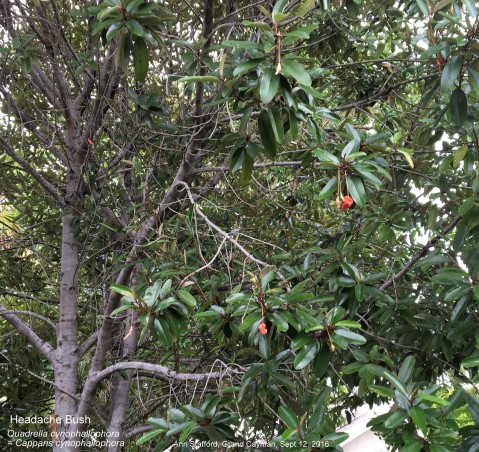
Headache Bush is a larval food plant of the Great Southern White butterfly – Ascia monuste.
Heart Plant – Ruellia tuberosa
Juniper, Jennifer (Bay Cedar – US) – Suriana maritima
An attractive bushy pantropical seashore shrub. In Cayman, the bark was rubbed off to make a poultice to deaden the pain of toothache.
Kings GC 22, LC 85, CB 57
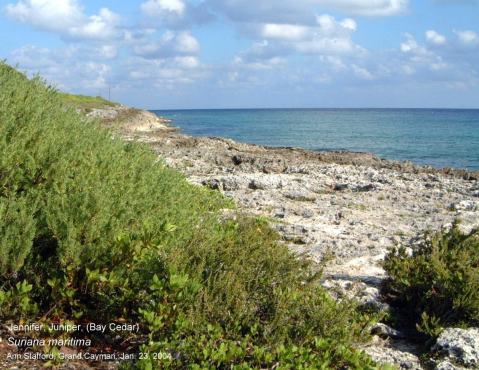

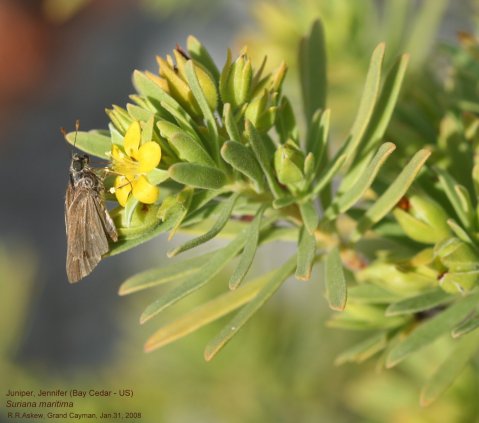 Juniper, Jennifer (Bay Cedar) is a larval food plant of the Cuban Grey Hairstreak (Strymon martialis) and Drury’s Hairstreak (S. istapa) butterflies and a nectar plant for several butterflies.
Juniper, Jennifer (Bay Cedar) is a larval food plant of the Cuban Grey Hairstreak (Strymon martialis) and Drury’s Hairstreak (S. istapa) butterflies and a nectar plant for several butterflies.
Bay Cedar – Suriana maritima – Natives for Your Neigh(borhood
Lavender, Sea Lavender – Tournefortia gnaphalodes (syn. Argusia gnaphalodes) Family: BORAGINACEAE. Dense, mound-like shrub, narrow leaves ALTERNATE, fleshy, velvety, silvery-grey. The fragrant white flowers attract butterflies. Seacoasts and saline shores, particularly sandy beaches. Bermuda, Florida, West Indies, and coasts of Yucatan, Cozumel, Belize and Venezuela. Photo: Ann Stafford, Pedro bluff, Grand Cayman, Feb.16, 2014. FLORA of the CAYMAN ISLANDS by George R. Proctor 2012 p.559, Fig.208, Pl.52.
In Cayman, a tea was made from boiled leaves for stomach problems and nerves
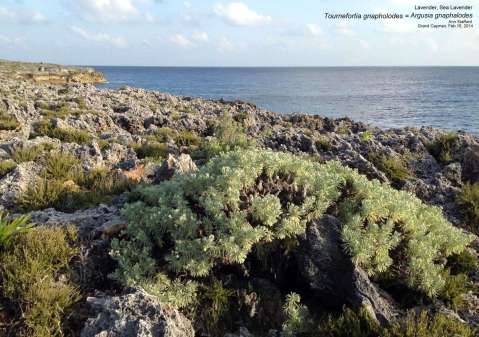
Sea Lavender – Tournefortia gnaphalodes (syn. Argusia gnaphalodes)
Sea Lavender – Tournefortia gnaphalodes
Leaf-of-Life, Curiosity Plant, (Cathedral Bells) – Kalanchoe pinnata (syn. Bryophyllum pinnatum), Family: CRASSULACEAE. Succulent perennial herb to 1m tall, leaves have scalloped edges, native to Madagascar, naturalized throughout the tropics.
In Cayman, the leaves were used to treat coughs, colds and sore throats, and to bathe swellings, sprains and bruises. It is called Leaf-of-Life, because when leaves fall on the ground, new plants sprout from the scalloped edges and take root.

Leaf-of-Life, Curiosity Plant – Kalanchoe pinnata
Lime – Citrus X aurantifolia
Liquorice, Wild, “John Crow Bean” – Abrus precatorius
Mulberry / Noni – Morinda citrifolia
Mulberry, Hog Apple, Noni, Duppy Soursop; Indian Mulberry – Morinda citrifolia is a shrub or small tree, naturalized in Cayman, leaves Opposite, flowers white. Fruit a fleshy, compound berry (synocarp), irregular shape, creamy-translucent when ripe, with a foetid odour. Native to tropical Asia and Australia, naturalized in the American tropics.
Mulberry / Noni leaves were used as a poultice for wounds to relieve pain, and as a treatment for rheumatic joints, fevers and headaches.
Kings LC 112.

Old Lady Coat Tail – Priva lappulacea
Naseberry, Sapodilla – Manilkara sapota
Pepper Cinnamon – Canella winterana CANELLACEEAE Canella Family
Critically endangered. Florida and the West Indies south to Barbados
Canella bark was used as an aromatic stimulant and tonic. In the 1700s, the inner bark was exported from the West Indies to Europe as a substitute for cinnamon. The outer bark is toxic.
The wood was used for Catboat sculls (oars).
Flora of the Cayman Islands by George R. Proctor, 2012 p.225, Fig.77, Plate 10.

The tree provides food and cover for wildlife.

Pepper Cinnamon – Canella winterana
Periwinkle – Catharanthus roseus
Pomegranate – Punica granatum
Providence Mint – Lippia alba
Rhubarb Root – Morinda royoc
Rosemary – Croton linearis
Note: The Cayman shrub, Rosemary, should not be confused with culinary woody, perennial herb, Rosemary (Rosmarinus officinalis), native to the Mediterranean region, or the variegated leaf landscaping shrub, Croton (Codiaeum variegatum).
A dioecious, pleasantly aromatic shrub, Rosemary (Pineland Croton or Granny-Bush – US) is a multipurpose plant. The leaves were steeped to make tea for striction, as a tonic, boiled to make a tea for diabetes or smoked as tobacco to relieve asthma.
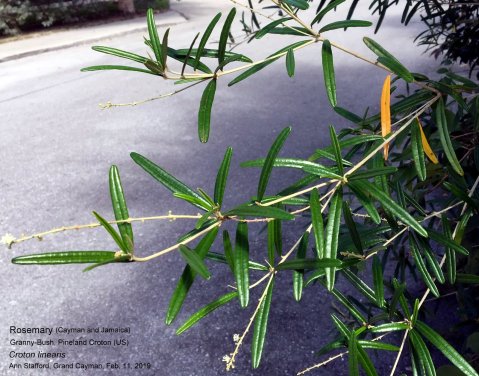
Rosemary brooms were made to sweep the interior of the house.
Rosemary is the larval food plant of the Cuban Red Leaf butterfly – Anaea troglodyta and Drury’s Hairstreak butterfly – Strymon acis and is a butterfly nectar plant.
Sage, Black – Cordia globosa var. humilis
Sage, White – Lantana camara
Scorn-the-Ground – Phoradendron quadrangulare and P. rubrum Mistletoe-like parasitic plants that grow on Cabbage Trees (Guapira discolor) in Grand Cayman, Rosemary (Croton linearis) in Little Cayman and Bull Hoof (Bauhinia divaricata) in Cayman Brac. P. rubrum grows on Cabbage Trees (G. discolor) and also on Mahogany.
The berries were used for women’s ailments (1938 Oxford University Biological Expedition).
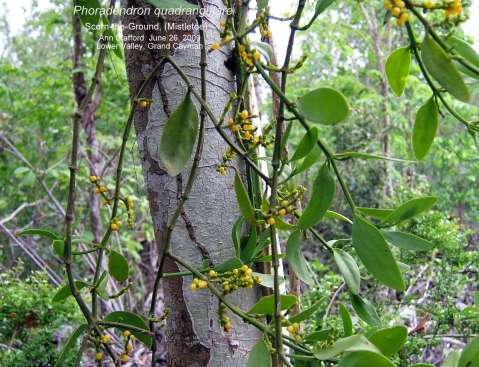 Scorn-the-Ground – Phoradendron quadrangulare, Kings GC 14, GC 150, GC 365, GC 388, CB 91
Scorn-the-Ground – Phoradendron quadrangulare, Kings GC 14, GC 150, GC 365, GC 388, CB 91
Scorn-the-Ground – Phoradendron rubrum, Kings GC 165, GC388, Lewis GC 14, LC 36, LC 43

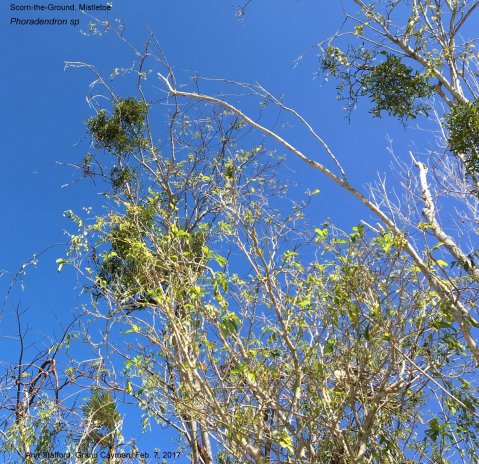 Scorn-the-Ground – Phoradendron sp, Colliers Wilderness Reserve Trail
Scorn-the-Ground – Phoradendron sp, Colliers Wilderness Reserve Trail
Scorpion Tail – Heliotropium indicum
Serasee – Momordica charantia

Soursop – Annona muricata
Strong Back, Kidney Bush, (Shiny-leaved Wild Coffee) – Psychotria nervosa, Family: RUBIACEAE, Vulnerable. Shrub up to 2.5m tall. Butterflies nectar on the white flowers, birds eat the fruit – red drupe. The leaves were used as a medicine for back trouble, a tea was made for kidneys and as a tonic.
Florida, the West Indies and continental America, variable.
Cayman plants grow is rocky woodlands. Culturally significant plant, suitable for use in landscaping.
Wild Coffee (Florida) does not contain caffeine. Seeds used as coffee substitute resulted in “only bad taste and terrible headaches”.
Flora of the Cayman Islands 2012 by George R. Proctor, p.629, Fig.240, Pl.62 Kings GC 316, Lewis GC 33a

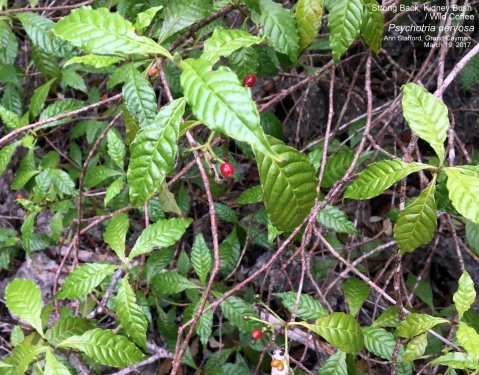
Strong Back, Kidney Bush / Wild Coffee – Psychotria nervosa
Wild Coffee – Psychotria nervosa
Tamarind – Tamarindus indica
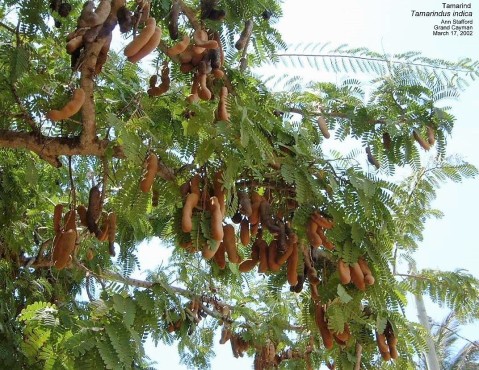
Tea Banker – Pectis caymanensis Critically Endangered
P. c. var. caymanensis Cuba and the Cayman Islands
P. c. var. robusta Grand Cayman endemic
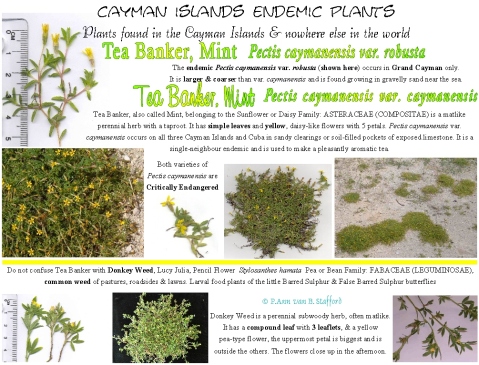
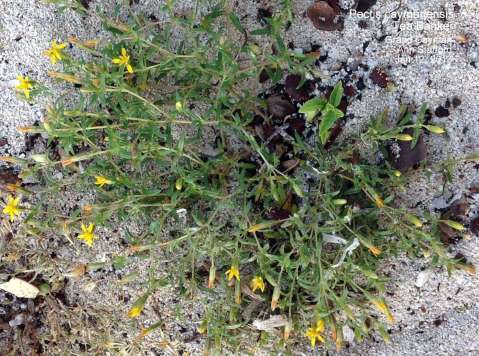
Tea Banker – Pectis caymanensis
History It was first recorded in the botanical literature of Grand Cayman in 1899 by Charles F. Millspaugh M.D. Department of Botany Curator, Field Columbian Museum, Chicago, Illinois. Millspaugh was a guest of Allison V. Armour, the Chicago meat-packing millionaire, on a West Indian cruise of the yacht ‘Utowana’; they visited the Cayman Islands during February, 1899. The chief set of Millspaugh’s specimens is in the herbarium of the Field Museum of Natural History in Chicago. Millspaugh published lists of his collection.
On February 8, 1899, the ‘Utowana’ stopped at The Creek ,‘Cayman Brae’ (Cayman Brac) A Norther sprang up in the night, so they had to leave for a point further west, where they anchored. They did some more collecting and then sailed on to Little Cayman, but found no safe harbour. They reached Georgetown (sic), Grand Cayman after dark on Feb. 9. The Health Officer forbade them to land as their last port (Port Antonio, Jamaica) was reported to be infected with measles. They were, however, given permission to go ashore elsewhere as long as they kept away from any other person or dwelling. Because of the Norther, they anchored at ‘Spot Bay’ (Spotts).
Tea Banker was originally called Pectis cubensis, it had been found in Cuba. Millspaugh found it on Grand Cayman on Feb.14, 1899: ‘Fine full masses of this species were found in the sand of the roadside at Spot Bay, Grand Cayman (1279), but not seen elsewhere on the island. It is called “Flat-weed,” and is used in infusion as a stomachic tonic.’ (Millspaugh, 1889)
FLICKER_4 Pectis caymanensis Dec 2009
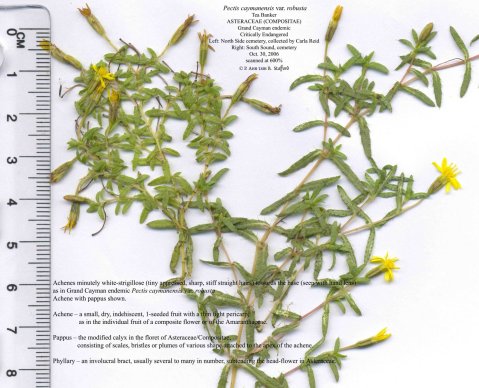
Conservation – Tea Banker is difficult to transplant. Although it can be grown from seed, it seems to require salt, such as at a beach ridge habitat, and fresh water, (when rain falls after the dry season), for the seeds to germinate.
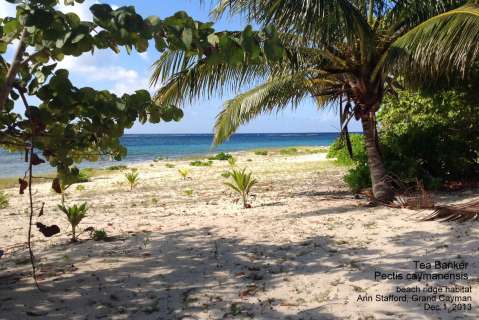
Thom Thistle – Argemone mexicana
Tittie Mollie – Euphorbia mesembrianthemifolia (syn. Chamaesyce mesembrianthemifolia)
Tobacco, Wild – Crossopetalum rhacoma
Vervine, “Worry Vine” – Stachytarpheta jamaicensis
Wormwood – Ambrosia hispida
The above list is based on HEALING PLANTS in the CAYMAN ISLANDS
compiled by Lorna McCubbin, March 15, 1995.
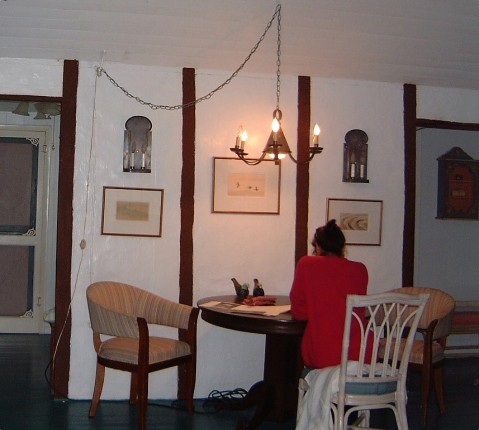 Lorna McCubbin in her Wattle and Daub house, with Ironwood posts, Cousin Cora’s Cottage, Boggy Sand Road, West Bay, Jan. 19. 2003.
Lorna McCubbin in her Wattle and Daub house, with Ironwood posts, Cousin Cora’s Cottage, Boggy Sand Road, West Bay, Jan. 19. 2003.
Other Healing Plants
“Caymania”, Desmodium – Desmodium adscendens
LOOK, DON’T TOUCH!
Beware of these plants!
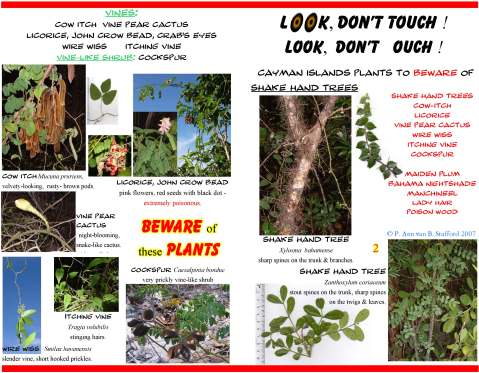

LOOK, don’t touch SEP20-06 text
Other Cayman Plants
native, non-native, cultivated, invasive
Bellyache Bush – Jatropha gossypiifolia, pantropical. Low shrub, leaves deeply divided, flowers deep crimson or purple. Proctor p.448 – Bitter Cassava, Wild Cassava
 Bellyache Bush – Jatropha gossypiifolia. Photo: Ann Stafford, Camana Way, Grand Cayman, April 10, 2009.
Bellyache Bush – Jatropha gossypiifolia. Photo: Ann Stafford, Camana Way, Grand Cayman, April 10, 2009.
Bulrush, Bull Rush, Rush, Cat-tail – Typha domingensis TYPHACEAE Vulnerable Wetland reed-like herb, with creeping rhizome (underground stem). In some countries, fibrous stems and leaves used for many purposes, eg thatch, soft matting, ropes and baskets. Downy wool of inflorescence can be applied like cotton to wounds and ulcers. Edible young shoots, said to taste like asparagus. Pollen can be used as flour to make bread, highly flammable.
Kings GC 216
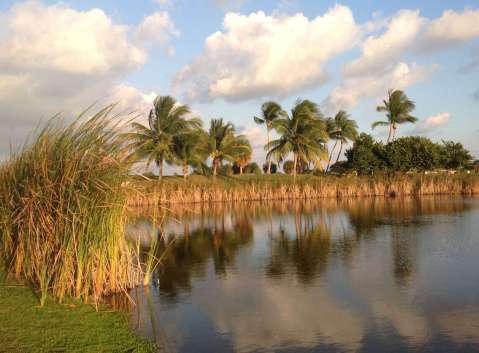


Bulrush, Bull Rush, Zamia (Coontie, Florida Arrowroot – US) – Zamia integrifolia CYCADACEAE. Critically Endangered. Zamia is DIOECIOUS. It is the larval food plant of the Atala butterfly, which flies on Cayman Brac, but not Grand Cayman or Little Cayman although Zamia grows on all three islands. Florida, Jamaica and Puerto Rico
Kings GC 256; PCB 1
Underground root-like stem/root used to make Bulrush Porridge, Bulrush starch, which was on display at the Jamaica Exhibition of 1891.
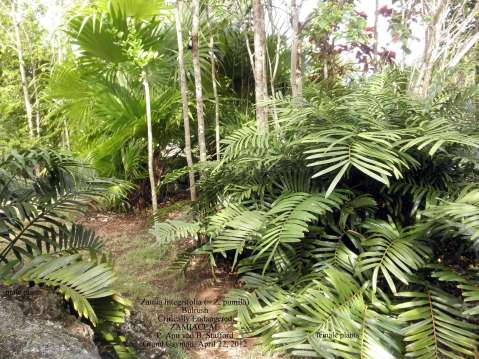 Zamia plant on left bears male cones, plant on right bears female cones which have bright scarlet seeds.
Zamia plant on left bears male cones, plant on right bears female cones which have bright scarlet seeds.
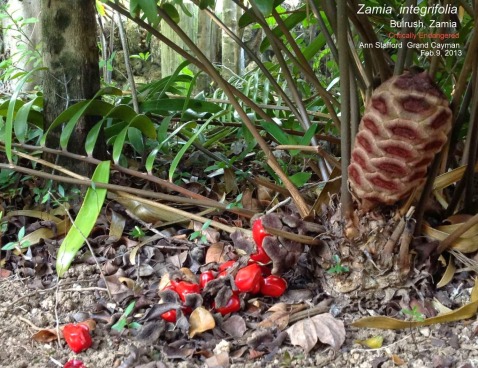
Jamaica International Exhibition 1891
Ref. A History of the Cayman Islands by Neville Williams 1970, p.65
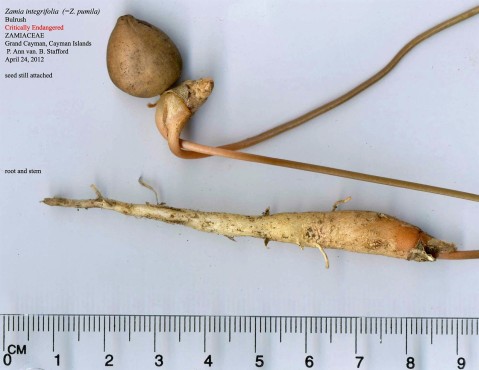 Bulrush, Zamia, starchy root and underground stem.
Bulrush, Zamia, starchy root and underground stem.
Candlenut, called ‘Walnut’ in Cayman – Aleurites moluccanus = A. moluccana (It is not related to the true Walnut – Juglans regia)
Cassava, Tapioca, Manioc, Tapioca, Yuca – Manihot esculenta. Native to Brazil. Kings GC 309, Proctor p.450

Cassava, Tapioca, Manioc, Tapioca, Yuca – Manihot esculenta
Cassava – Manihot esculenta Extract: There are several named cultivars available. The primitive “bitter cassavas” contain large amounts of cyanide and need a great deal of processing to make their roots edible. The modern “sweet” cultivars require only peeling and cooking.
Cassava meal and tapioca are made by grinding the roots in water and then evaporating off the liquid which includes the cyanide compounds. Products made from the cassava root include yuca, tapioca pudding, farinha, starch, soaps, glue, sugar, alcoholic drinks, acetone and cyanide. In tropical Asia the tender young leaves are boiled and eaten. In the Caribbean, juice extracted from cassava roots is flavored with cinnamon, cloves and sugar and called cassareep; it is used for preserving and flavoring meats, and is an essential ingredient in pepperpot stew.
Warning: All parts of the cassava plant are poisonous and must be processed by peeling, pressing or cooking before eating. It is reported that the Caribbean Arawak Indians committed suicide be eating raw cassava rather than face slavery under the Spanish invaders.
Coral Plant – Jatropha multifida, ornamental, butterfly nectar plant
Ghost Orchid* – Dendrophylax fawcettii* Grand Cayman endemic Critically Endangered
Kings GC 19, GC 19a
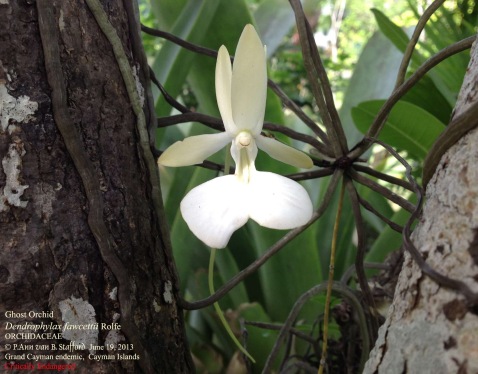
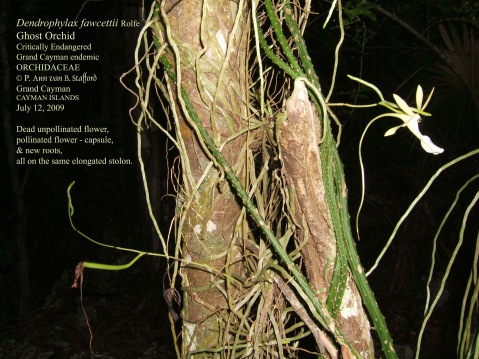 Ghost Orchid – Dendrophylax fawcettii, Grand Cayman endemic, has no pseudobulbs or leaves. The very fragrant night-scented flowers may attract Sphinx (Hawk) Moths to pollinate them, probably the Giant Sphinx Moth – Cocytius antaeus medor. The photo above shows a dead. unpollinated flower, a pollinated flower forming a fruit (capsule) and new roots, the beginning of a new plant, all on the same stolon (elongated stem). The larval food plant of this moth was likely to be native Pond Apple – Annona glabra, before other Annona species were introduced: Soursop – A. muricata, Sweetsop, Sugar Apple – A. squamosa and Custard Apple, Bullock’s Heart – A. reticulata.
Ghost Orchid – Dendrophylax fawcettii, Grand Cayman endemic, has no pseudobulbs or leaves. The very fragrant night-scented flowers may attract Sphinx (Hawk) Moths to pollinate them, probably the Giant Sphinx Moth – Cocytius antaeus medor. The photo above shows a dead. unpollinated flower, a pollinated flower forming a fruit (capsule) and new roots, the beginning of a new plant, all on the same stolon (elongated stem). The larval food plant of this moth was likely to be native Pond Apple – Annona glabra, before other Annona species were introduced: Soursop – A. muricata, Sweetsop, Sugar Apple – A. squamosa and Custard Apple, Bullock’s Heart – A. reticulata.
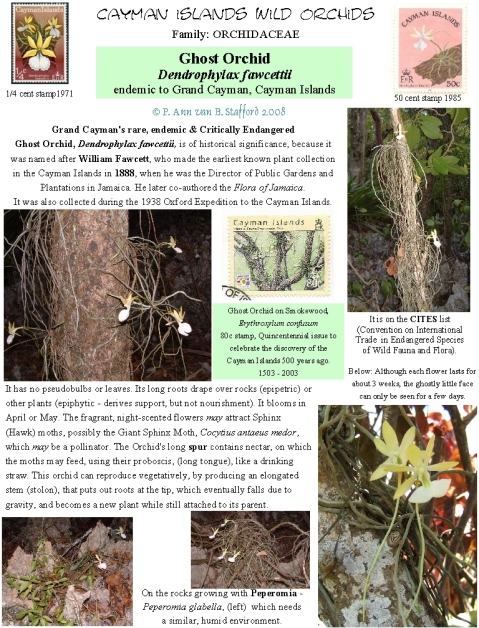
Old George* – Wittmackia caymanensis* syn. Hohenbergia caymanensis
Grand Cayman endemic, Critically Endangered giant Bromeliad, that grows on the rocks or in trees.
Rothrock Winter of 1890-1891; Kings GC 196
 Old George – Wittmackia caymanensis syn. Hohenbergia caymanensis in its natural habitat in the Ironwood Forest, SE of George Town.
Old George – Wittmackia caymanensis syn. Hohenbergia caymanensis in its natural habitat in the Ironwood Forest, SE of George Town.
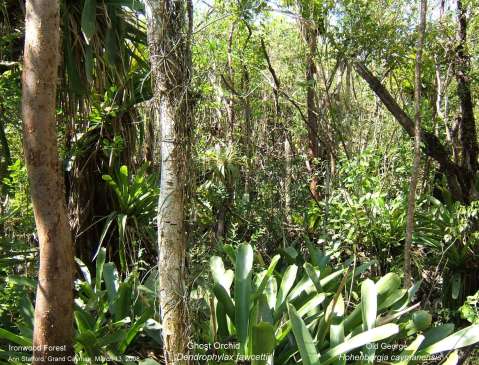 Old George, growing on phytokarst and on trees, and Ghost Orchid, in their natural habitat. Both are Grand Cayman endemics.
Old George, growing on phytokarst and on trees, and Ghost Orchid, in their natural habitat. Both are Grand Cayman endemics.
Peregrina – Jatropha integerrima, native to Cuba; ‘Compacta’ is a smaller, more compact cultivar, ornamental, butterfly nectar plant
Physic Nut – Jatropha curcas, shrub or small tree with viscid milky or reddish sap. Proctor p.448
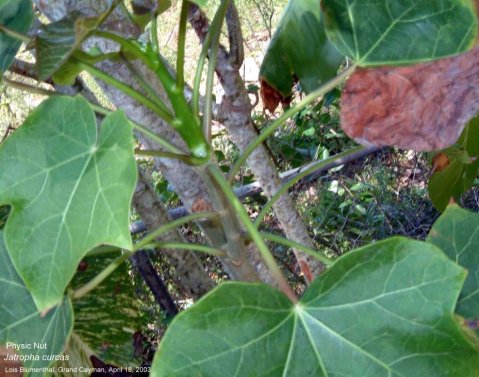
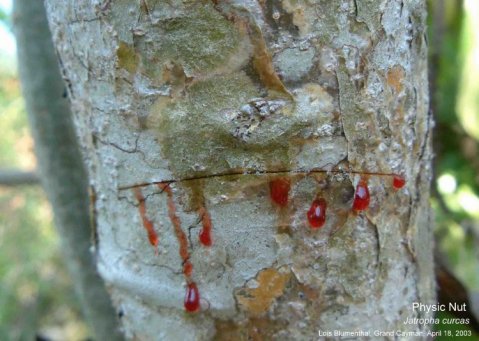
The Whole Truth by C. Dennis Adams
It is quite true that if you cut the bark of the Physic Nut Tree, Jatropha curcas, at noon on Good Friday it will bleed red. It is also true that if you cut it at 10am on August 28 or 3pm on January 5 it will bleed red. This does not of course bear on any conflict between Science and Religion; the matter has little to do with either, but is one of stating what is true and, by omission and implication, what is false. An incomplete statement can be as misleading as a purposely inaccurate one.
What in effect we have here is a trick to impress the gullible. Those who carry out a simple investigation can find out how the trick is made to work convincingly.
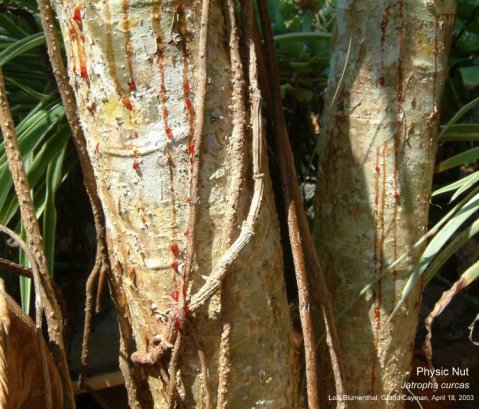 Physic Nut – Jatropha curcas, 10 minutes later. Photo: Lois Blumenthal, April 18, 2003.
Physic Nut – Jatropha curcas, 10 minutes later. Photo: Lois Blumenthal, April 18, 2003.
Wild Oil Nut – Jatropha divaricata, monoecious shrub, native to Jamaica and Grand Cayman only. Found near Forest Glen and along the Mastic Trail. Critically Endangered. Proctor p.448

Wild Oil Nut – Jatropha divaricata
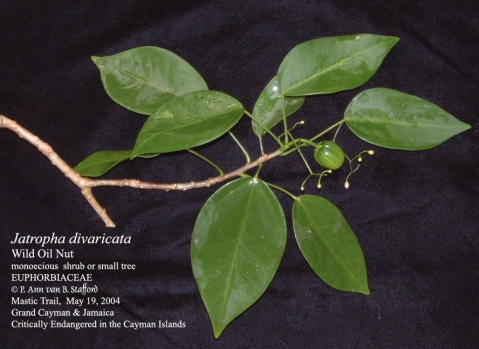 Wild Oil Nut Jatropha divaricata fruit, Mastic Trail, May 19, 2004
Wild Oil Nut Jatropha divaricata fruit, Mastic Trail, May 19, 2004
Botanists and collectors
William Fawcett May 1888
John T. Rothrock “Winter of 1890-1891”
A. S. Hitchcock Jan. 1891
Charles F. Millspaugh Feb. 1889
C. A. Mately Jan. 1924
Wilfred Kings May-Aug. 1938
C. Bernard Lewis Apr. 1938, Dec. 1944, Mar. 1945, Dec. 1945
C. M. Maggs June 1938
George R. Proctor Feb. 1948, Apr.-May 1956, June-July 1967, Aug. 1968, Nov. 1968, Sep. 1969, Aug. 1975, Nov. 1991-Apr. 2004 (15 short collecting trips)
Marie-Helene Sachet Sep. 1958
Robert A. Dressler May 1964
Richard A. Howard & B. Wagenknecht Jan. 1969
Martin Brunt May-June 1967
Jonathan Sauer June 1967
John Popenoe Apr. 1969
Donovan S. & Helen B. Correll Nov. 1979
G. F. Guala June 1998
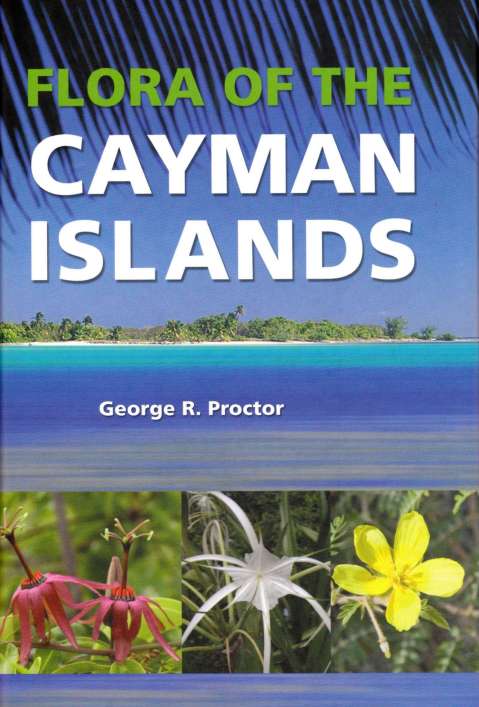 Flora of the Cayman Islands
Flora of the Cayman Islands
by George R. Proctor 2012 Kew Publishing

Dr. Proctor, nearly 84 years old, with his specimen box, on the Mastic Trail, Grand Cayman. Photo: P. Ann van B. Stafford, April 6, 2004.
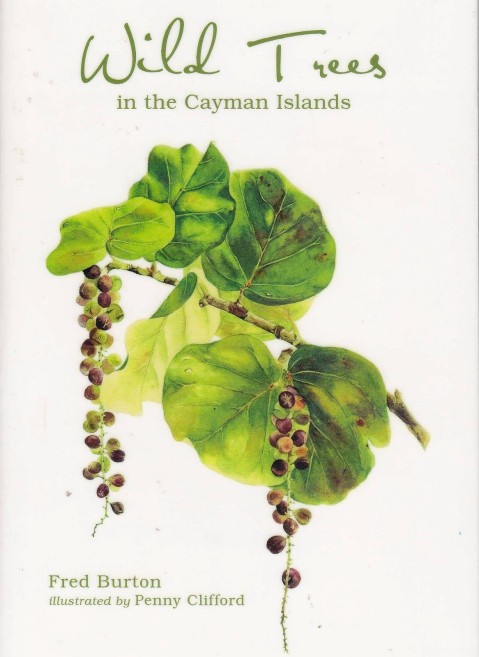 Wild Trees in the Cayman Islands
Wild Trees in the Cayman Islands
by Fred Burton, illustrated by Penny Clifford, first published 1997
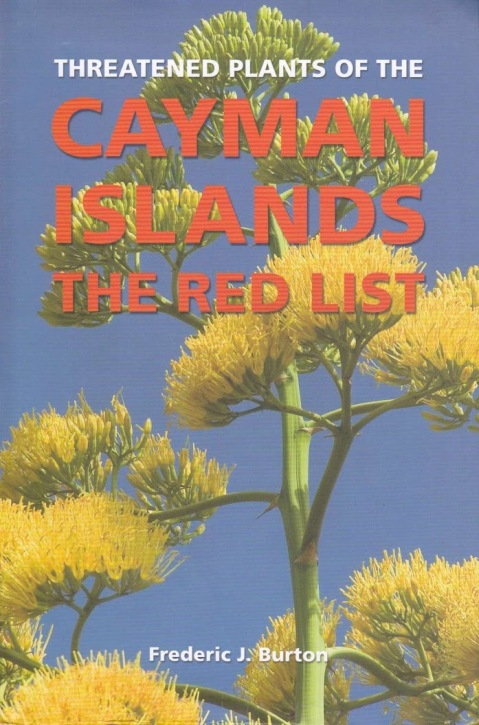 Threatened Plants of the Cayman Islands The Red List
Threatened Plants of the Cayman Islands The Red List
by Frederic J. Burton, Kew Publishing 2008.

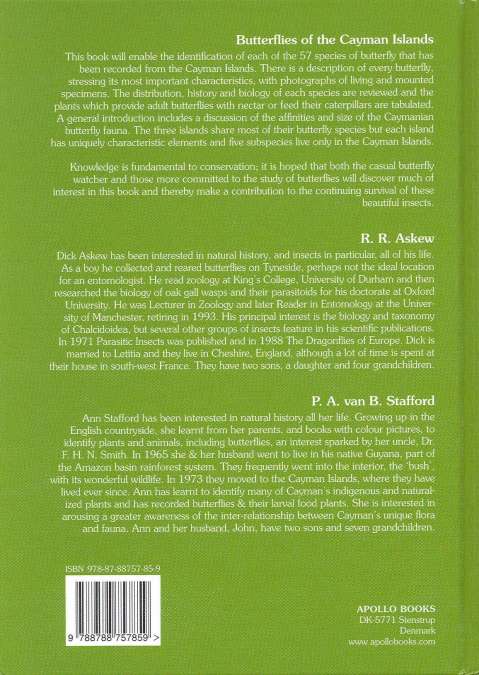 Butterflies of the Cayman Islands
Butterflies of the Cayman Islands
by R. R. Askew and P. A. van B. Stafford, Apollo Books 2008
This book includes the butterfly larval food plants in Cayman.

Caribbean Sea


1773 Gauld map of Grand Cayman
Dates of Importation of Plants to Bermuda
from 1593.
Bermuda Plants Importation dates
